

WHAT ARE WE WASTING? WE CAN BE THE SOLUTION.
Waste Rebels
Zijue Wei
Olivia Hilton
Folasade Lawal
Jinyu Li
Alisha Giles
Yingheng Zhang
Issac Prandy
Rahat Ali
Zijue Wei
Timeline & Contents
Olivia Hilton
Folasade Lawal
Jinyu Li
Alisha Giles
Yingheng Zhang
Issac Prandy
Rahat Ali
• Unit brief and lecture
• First meet with group members
Research into climate change individually
First tutorial:
First meet tutors and introduce to groupmates
Week 1 - Introduce/Discover/Define
31st Oct - 6th Nov

Research different art forms and styles
Second tutorial and group meeting online: Choose our theme and styles
Explore on 3D posters
Design exhibition set-ups
Third tutorial and group meeting online:
• Decide target audience, group name and slogan
• Decide exhibition set-ups
Week 2 - Introduce/Discover/Develop
Nov - 13th Nov
Week 3 - Define/Develop
Nov - 20th Nov

Experiment 2D posters
Work on exhibition set-up and micro model
Keep on poster designs
Fourth tutorial and group meeting online:
• Add one more poster series
• Make waste shift poster
• Group presentation
Work on digital submission
Design logo
Week 4 - Develop
Nov - 27th Nov

Week 5 - Develop/Deliver
Nov - 4th Dec

Work on new poster series
Final online meeting:
Work on 4 posters about impacts of waste
Exhibition preparation
Decide the details for exhibition Exhibition

Week 5 - Exhibit 5th Nov - 11th Dec


The group members represented by these colours are coorperating. The group members are working individually.

Body texts:
What we were doing well?
What made us do well?
What we were not doing enough?
How can we improve?


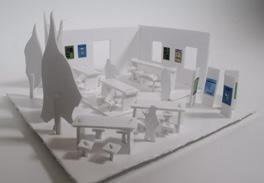
Zijue Wei
Evaluator
Critic
Bringing 3D concepts into the design
Communicating new ideas with group members
Making reflection on current progress
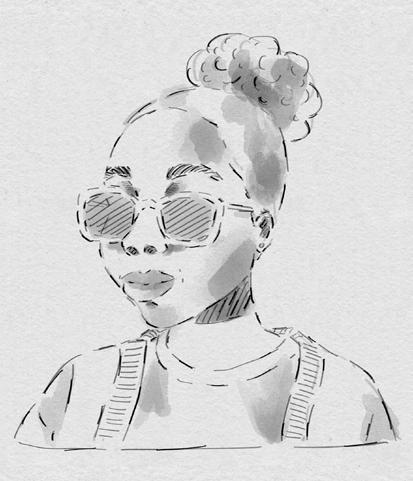


Folasade Lawal Organizer
Initiator
Organize group meetings
Bringing up new ideas
Creating 2D posters
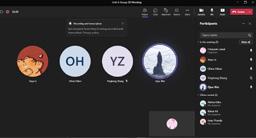


Alisha Giles
Compromiser
Creating 2D posters



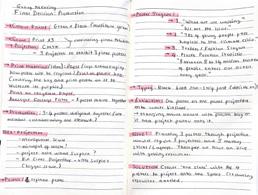
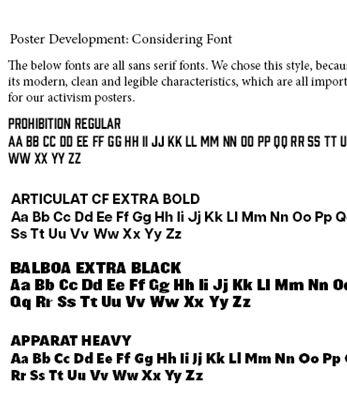




Olivia Hilton
Notetaker
Coordinator
Summarizing meetings and tutorials
Creating 2d posters
Coordinating ideas
Jinyu Li
Compromiser
Creating 2D posters
Creating exhibition set-up
Bringing 3D concepts into the design
In the poster project, we suggested that we need to be the solution to waste issues that are jeopardizing our earth. In our posters, we told people that our earth is not in the worst situation, and humans can still have a better environment and a more hopeful future if we take actions to reduce waste, both before and after the waste is produced.
Yingheng Zhang
Compromiser
Creating 2D posters
As a group, our collaboration was not smooth at the beginning but ended up with a satisfying result. We conquered a variety of technical and interpersonal problems. We are relieved that we did reach a good end, and we gained useful skills and knowledge that will help us out of difficulties in the future.
?


Collective creative response to the question:
“What are we wasting?”
The collage poster represents the whole process of our group working on this project. It is an important turning point for us, to first start collaborating and understanding each other.
Issac PrandyZijue Wei
WEEK 1 - Introduce/Discover/Define
After meeting each other at the Design Museum, we started our investigations in various fields of environmental protection.
Olivia Hilton
Folasade Lawal
Jinyu Li
Alisha Giles
Yingheng Zhang
Issac Prandy
Rahat Ali
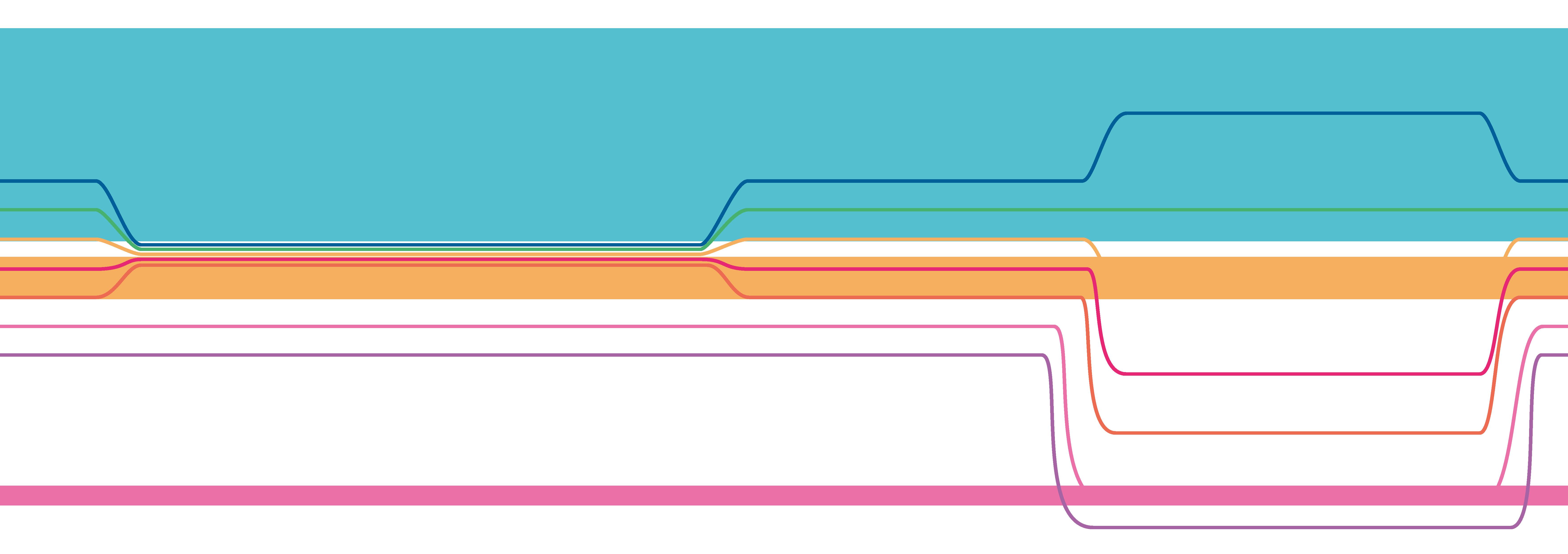
First group meeting:
• Task for the first week: Look for information about climate change from different angles, such as existing problems, actions that have been taken, climate data, etc.
Unit brief
• Lecture about climate crisis and a variety of art forms responding to climate issues
Visiting the Design Museum
Reflection: Lack of communication and understanding
In the first week, we did not talk about our opinions on the climate crisis and knew nothing about other people’s interests.
We should establish effective communication before we started. By getting to know each other about their academic curiosities, personal interests, and thoughts about the unit themes, we could have a clearer direction of research.
Sea level rise / Overconsumption / Excessive waste
Waste disposal
Waste acumulation / Sustainable development / Human health
Stubble burning / Landfill / Ocean pollution
Recycling plastic
Global warming / Natural disasters

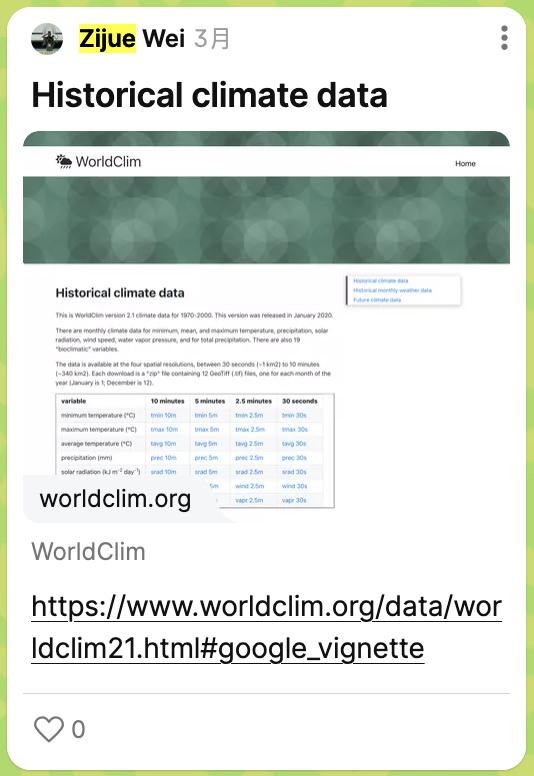

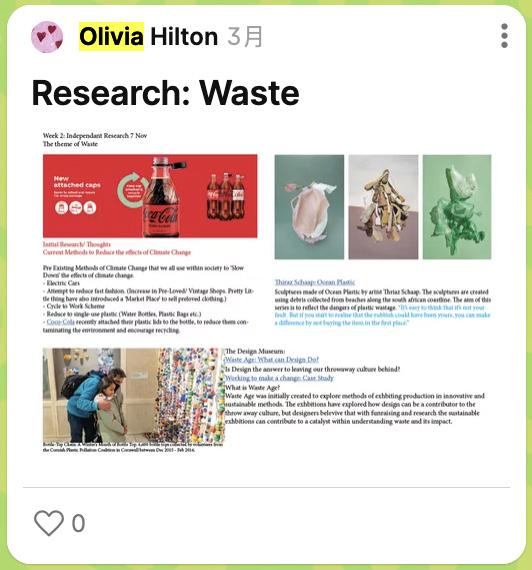

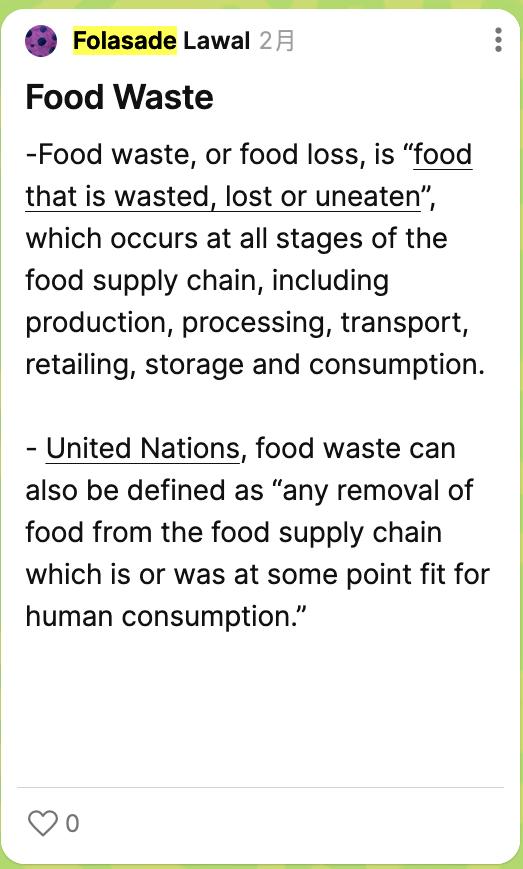
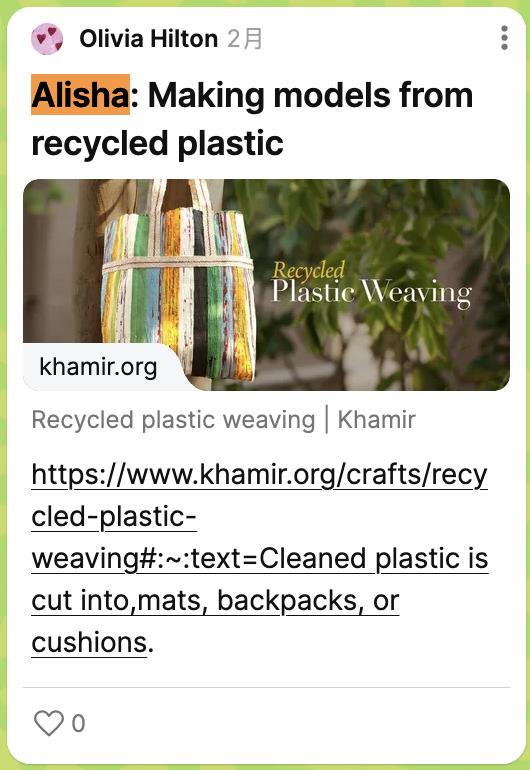

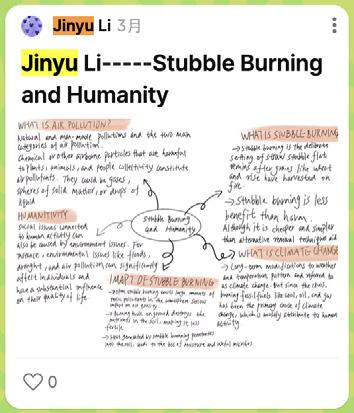
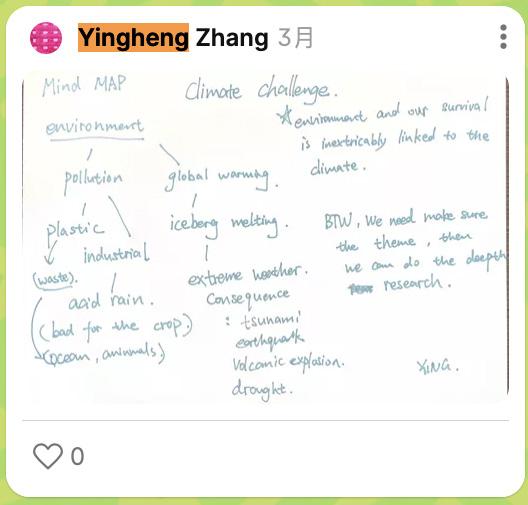
Week 1 contents from group padlet
Researching: climate crisis
Researching: climate crisis
Excessive Waste Overconsumption
Waste is expanding its territory and competing with humans for more space. Waste pollution gives humans diseases, insanitation, and a dusky sky. They are slowly killing us physically and mentally, and humans have to spend more and more money and human resources to defend against them.
All products can be overconsumed, but they can all be traced back to the same origins: overestimated purchasing power and inflating desire.
In the close circle of production-purchasing-disposal, overconsumption affects both the two phases before and after it. The more people buy, the more production is encouraged, and more trash is left over. Overconsumption not only takes valuable resources from the earth, but also leaves tons of unused waste for her.

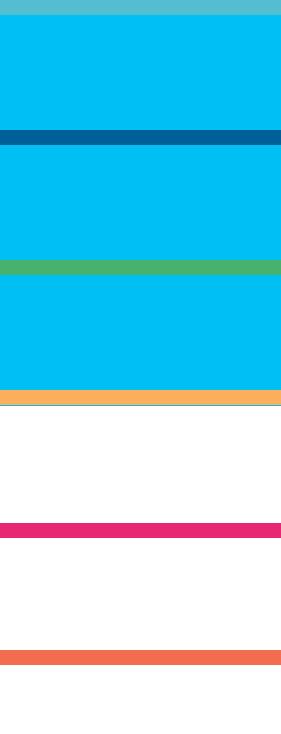


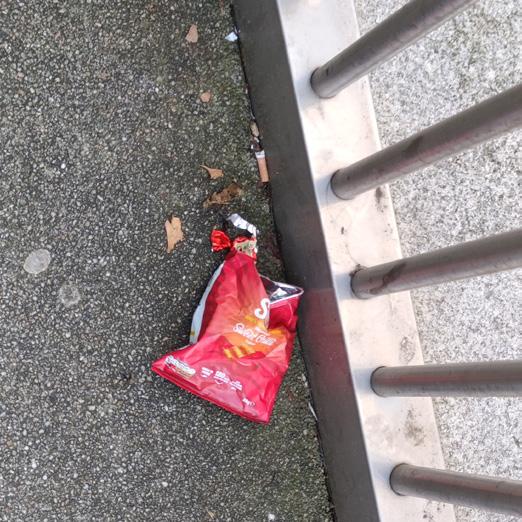
“We are arguably living in the waste age,” says Justin McGuirk, the London museum”s chief curator, who has spent the last three years rifling through rubbish with co-curator Gemma Curtin to put together this timely show. “The production of waste is absolutely central to our way of life, a fundamental part of how the global economy operates. We wanted to show how design is deeply complicit in the waste problem – and also best placed to address it.”
(Wainwright, 2021)
“This shocking rise in plastic litter incidents suggests that plaastic is a growing threat to animals. Every year, the RSPCA deals with increasing numbers of mammals, birds and reptiles that have become entangled or affected in some way by discarded plastic. From seals with deep infected wounds caused by plastic frisbees cutting into their necks, to swans and geese trapped in fishing line or netting, plastic is clearly having an increasing impact on animal welfare. Our latest data sadly reflects the wider litter crisis taking place right now across the globe and action is urgently needed. It’s up to every one of us to do our bit in the war against litter.” (Ravenhall, 2019)



Relation between household energy footprint and household income
5 Questions To Ask Yourself Before You Buy:
1. Do you really need it or are you just buying it because it’s on sale?
2. Can you get it for less?
3. Can you afford it?
4. Is it an impulse buy?
5. Can you get it for free? (Morgan, n.d.)
“ABSOLUTE petty post, but feel like every influencer that follow/ed would share their ‘hauls’ from Amazon, Target, their grocery store hauls, and just random clothes/ shopping sprees....Like yea, you need groceries to eat, blah blah blah, but also like.... howwww do they shop so much?? And then you never see that item again? Or they just get stuff ‘because couldn’t resist, it was just so cute’???” by @u/samberchamp on Reddit
“When you don’t have these religious structures, which are guiding you and defining who you ought to be, what ends up happening is people still seek meaning,”
Stephanie Alice Baker, a senior lecturer in sociology at the City University of London, told Mashable in a previous article. “You still need somebody to give them this sense of purpose. And so this is where you often find a lot of celebrities or influencers filling this void.” (Silva, 2022)
 By Zijue Wei
By Folasade Lawal
By Zijue Wei
By Folasade Lawal


 Primary research on rubbish on roads
Research into impacts of plastic waste
Wardrobe Crisis
Primary research on rubbish on roads
Research into impacts of plastic waste
Wardrobe Crisis
Circular economy
To build the circular economy, we need support from both consumers and corporations. We must identify the stages in industrial processes where we can intervene to reduce waste and excessive resource consumption.


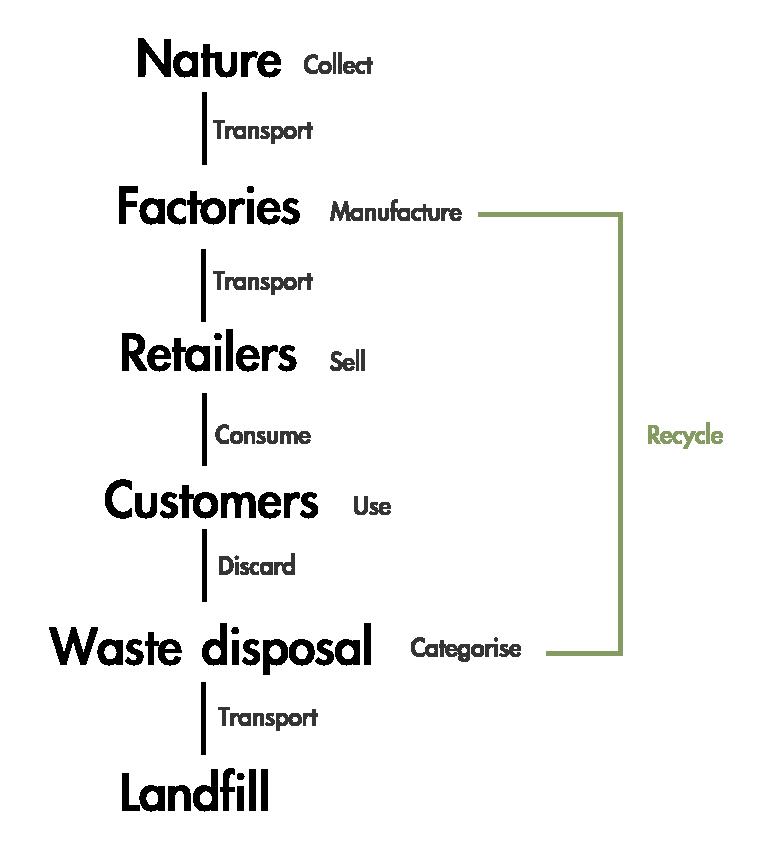 By Zijue Wei
By Zijue Wei



“A circular economy is an economic model designed to minimize resource input, as well as waste and emission production. Circular economy aims to reach the maximum efficiency in the use of finite resources, the gradual transition to renewable resources, and recovery of the materials and products at the end of their useful life. Moreover, it targets to rebuild all available types of capital, including financial, human, social, and natural. Essentially, a circular economy describes a regenerative economic system.” (CFI Team, 2022)
“The circular economy, when designed in a thoughtful and inclusive manner, has the potential to protect the environment, improve economics, and elevate social justice. Sustainability from its foundation requires social equity. How we extract, use, and dispose of our resources can affect already vulnerable communities disproportionately.” (EPA, 2022)
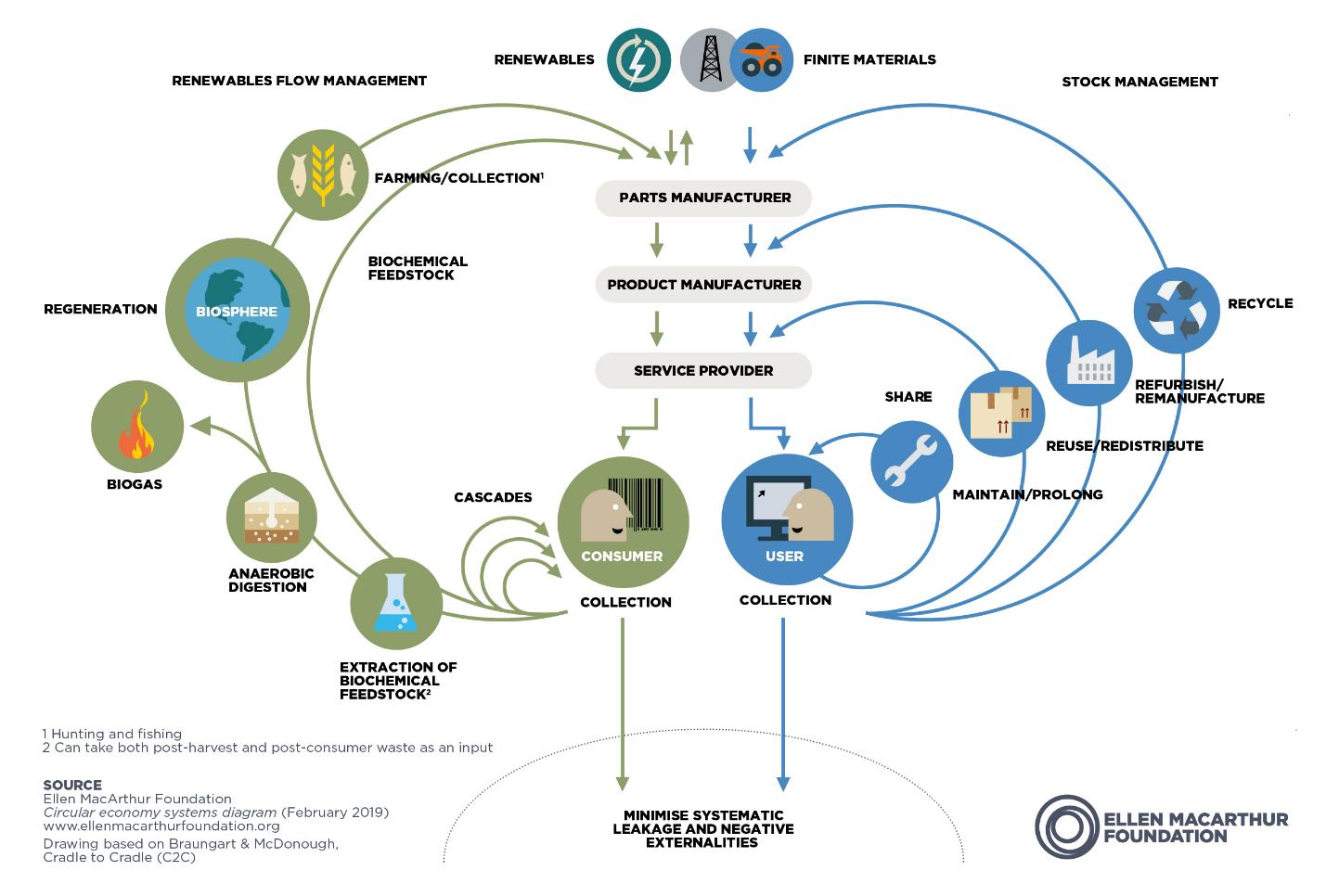


Zijue Wei
WEEK 2 - Introduce/Discover/Develop
Continuing our research into excessive waste and further study about different art forms we could use for our group project.
Olivia Hilton
Folasade Lawal
Jinyu Li
Alisha Giles
Yingheng Zhang
Issac Prandy
Rahat Ali
Discuss future plans:
• Following the theme of waste, look for previous works done by artists, scientists, entrepreneurs...including art, technologies and business strategies
• Make creative responses based on the research we have done
Ice breaking: Introduce ourselves to the group and the tutor with a short presentation
• Make a presentation about our personalities, preferences, previous works and interests

Previous works
Creative responses
Recyclable architectures / Charity shops / Sell electricity back
Energy bank / Activity centre plan / Activism posters

Sustainable brands / Art pieces made of waste
Collages made of waste / Activism posters
Illustrations
Reflection: Great diversity
Our group members have very diverse ways of seeing things, and this had made our perspectives broad and inclusive. We could learn from others’ viewpoints and incorporate them into our own knowledge.
Recycling waste
Activism posters
Sculptures made of waste masks
Activism posters
Activism posters
Reflection: Lack of communication
Since last week, we had not talked much about what we were working on. Even though there were online meetings about our progress, we only talked about what we did without really understanding our purposes in this unit. We just looked at the work and gave bland comments, and never thought of how we could relate our work to others’. Without realizing that we are a group working together, any useful progress cannot be made.
We must try to understand other people’s ideas and work, and be willing to question and be questioned ourselves. In-depth communication helps us understand our ideas better, and others can also give helpful opinions to improve them.
What did human do to reduce waste?
Illustrations Buildings Actions


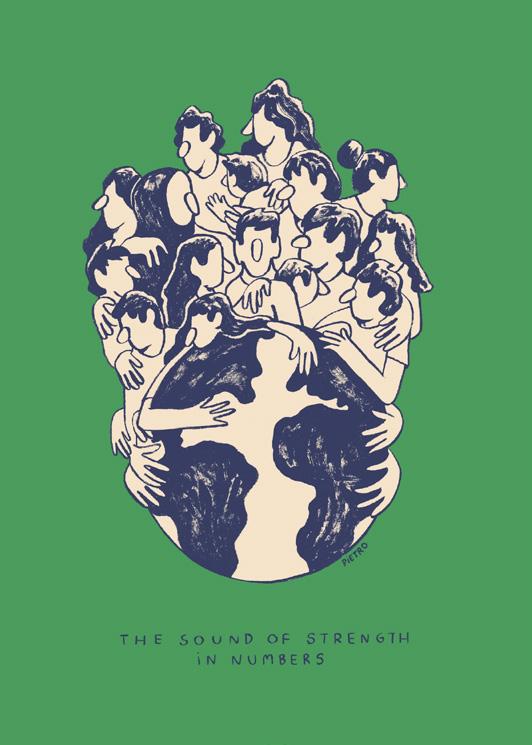 By Pietro Soldi
By Pietro Soldi

The poster expresses the idea of standing together for our earth in a simple and emotional form, that makes this poster invigorative.

There is an intriguing way of combining 3D spaces into the 2D plane while emphasizing the slogan ZERO WASTE.
In summary, there are three main themes within environmental protection posters:
•Impacts
•Actions
•Benefits
These key words convey the messages of environmental care most efficiently.

 By Fridtjof Kirste
By Fridtjof Kirste
The metaphor of the gun creates a strong idea and a powerful emotion in this poster.
 By Ryan James By Daniel Lievano
By Ryan James By Daniel Lievano
A positive attitude is emphasized in this poster. By showing the good results of nurturing, eco-friendly behavior is encouraged.
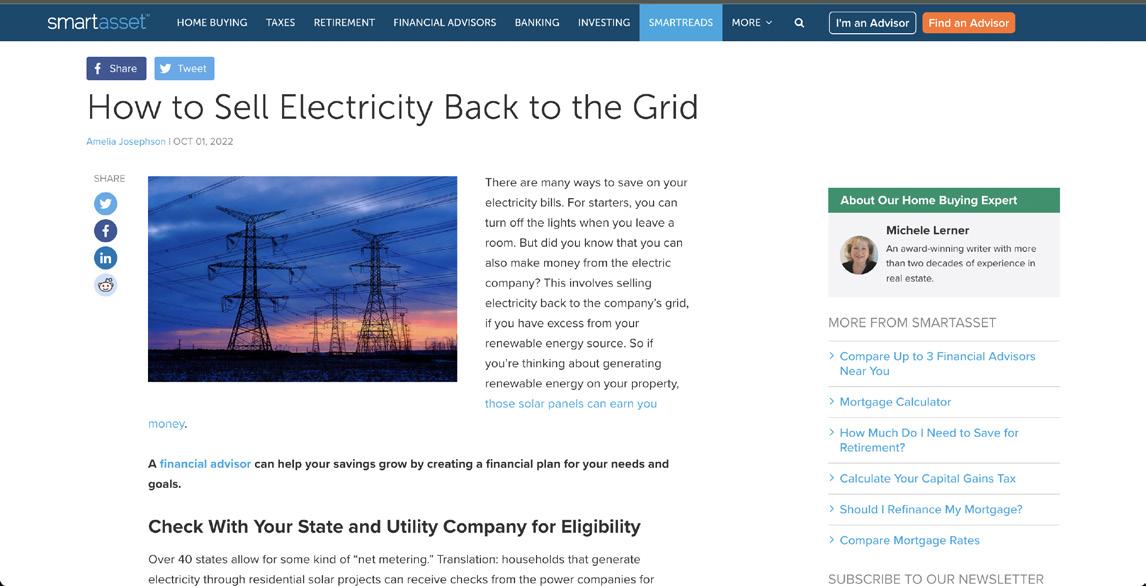
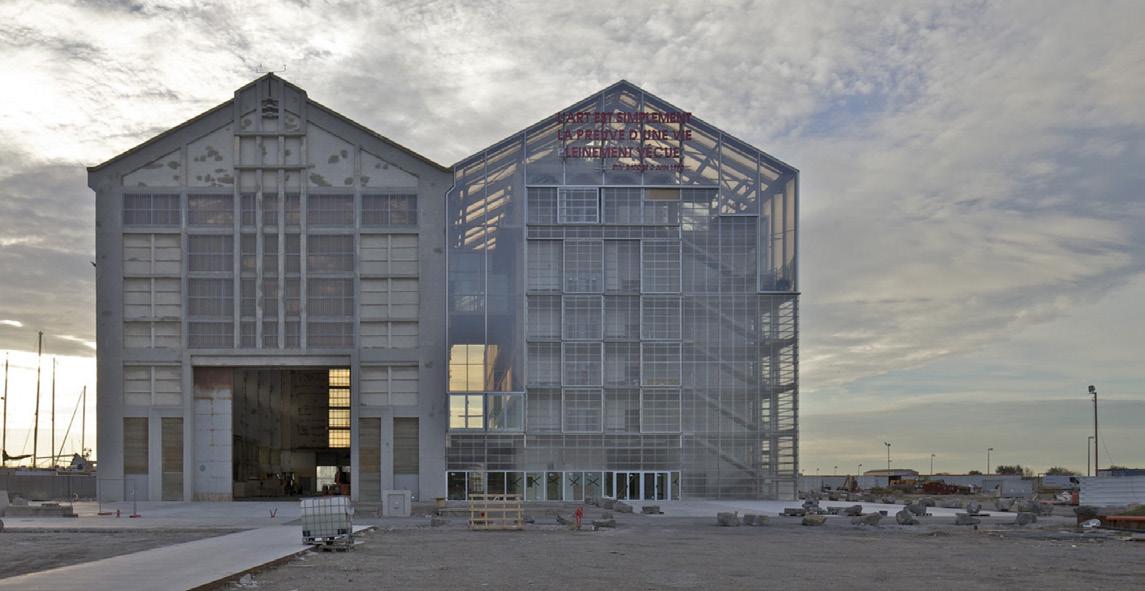
Some associations and corporations are contributing to environmental protection. For example, the website “Good on You” provides information about fashion brands, such as whether they are sustainable. Some electricity companies allow people to sell electricity back to them, and tax breaks are available to owners of environmentally friendly homes.
Architects are also exploring more possibilities of sustainable buildings. Some designers use waste as the construction material, and some design buildings that can be recycled easily. There are also architectures that can transform waste into energy.


 Web page of Good on You
Web page about selling back electricity
House Rehabilitation by BAST
Web page of Good on You
Web page about selling back electricity
House Rehabilitation by BAST
Creating:
What can our group do to reduce waste?




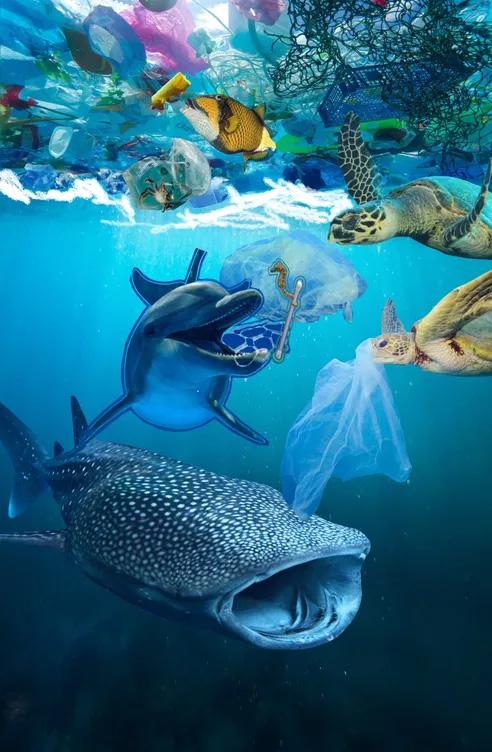 By Folasade Lawal By Olivia Hilton By Alisha Giles
By Folasade Lawal By Olivia Hilton By Alisha Giles
When discussing the consequences of waste, we first came up with the idea of a poster series to show the variety of impacts caused by waste. By getting to know the bad results of waste, people can be aware of what they are wasting and encouraged to reflect on their past behaviours.

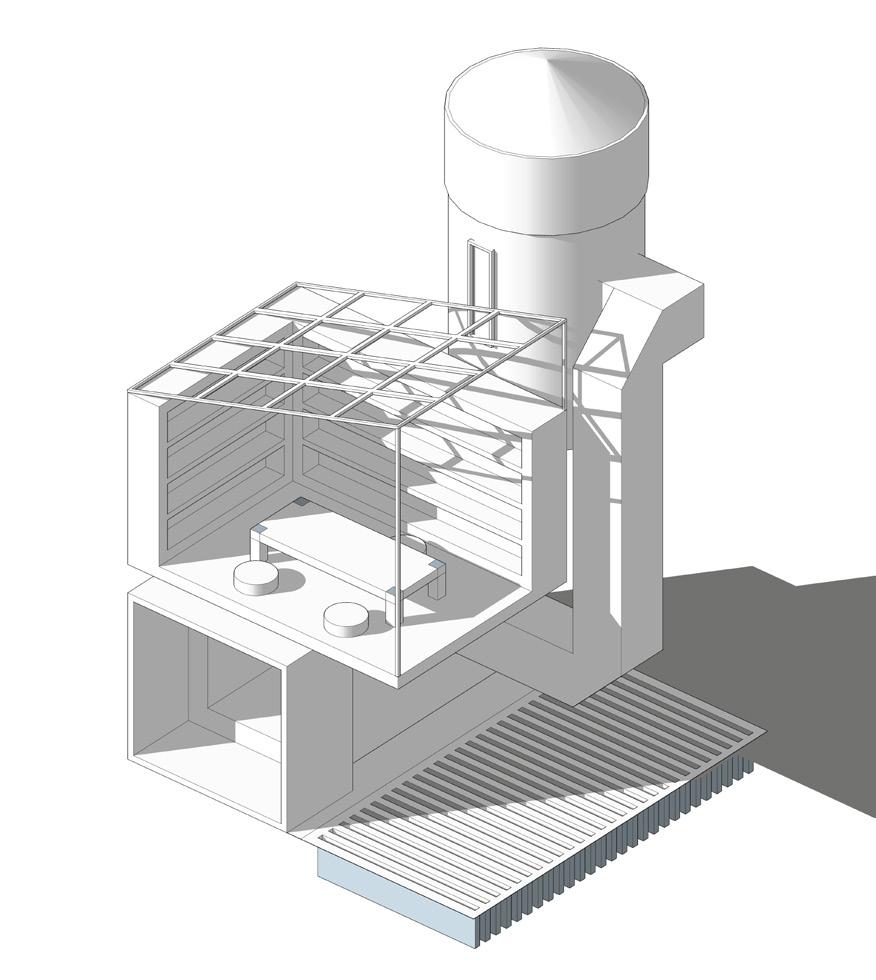

 By Zijue Wei By Zijue Wei By Jinyu Li
By Zijue Wei By Zijue Wei By Jinyu Li
The poster about transforming waste into benefits talks about an action that motivates people to recycle by showing and giving them those benefits, such as children’s education and money savings. The poster can also be an advertisement for a certain activity or association, that helps bring about these benefits.


Zijue Wei
WEEK 3 - Define/Develop
Looking for target audiences and backgrounds for our posters. Starting to visualize the poster in different ways.
Olivia Hilton
Folasade Lawal
Jinyu Li
Alisha Giles
Yingheng Zhang
Issac Prandy
Rahat Ali

Second tutorial:
• Discuss the thumbnails we did
• Choose the theme and art form for our final outcome: activism posters responding to waste issue Group online meeting:
• Discuss sketches of posters
• Comment on each others’ works and give suggestions: combining text with drawings, collage, etc.
Reflection: Proactivity
We were all developing our ideas and designs on our own this week, so we had a lot to share with the rest of the group. All the different approaches helped with conceptualizing our creative responses.
Continue to research in different fields individually
Combine theme of waste with 3D concepts and interior design Conceptualise exhibition plans
• Use Triangle Space as the base of the design: triangular layout of posters/embedding posters in walls
• Use a representative public space as the base of the design: organic shaped pavillion/cafe
Develop posters:
• Think of different aspects of waste issue: about mental health, fashion, oceans, etc。
• Design drawings on posters
• Experiment with different fonts: sans serif family, hand written, etc。
Reflection: Unreasonbale work division
However, our work division was not fair. Some group members who talked less were excluded from the discussion, and sometimes the ideas they gave were ignored. When making plans for the week after, these members were not considered part of the plan and had to work alone. If they continued working on their ideas without any feedback or comments from groupmates, their ideas would develop in a subjective and arbitrary way, which would not help with our collaboration.
In a discussion, what we can do is encouraging others to talk and trying to get most group members involved in the communication. We need to resolve any disagreements or confusions in the group in time.
Who is our target audience?
What age bracket do you fall into? Where in UK do you live? Are you interested in learning more about ‘Waste Conscious’?



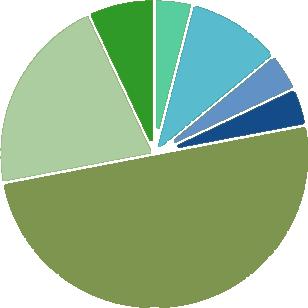
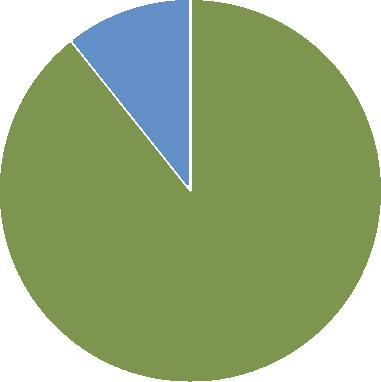
12-17 years old
18-24 years old
25-34 years old
35-44 years old
45-54 years old
55-64 years old
65-74 years old
North East
North West
Yorkshire and the Humber
We chose to design posters for the younger generations in London after this survey as they are willing and energetic to know more about waste consciousness. Posters, as our final selection of art form, can easily be spread in the physical world and on the Internet.
When conducting the survey, we did our best to collect as many responses as possible from different areas, age groups, and industries. However, the results we got were still limited, since the diagrams show that most subjects are in the age range of 18–24, which is not reasonable or reliable for a social survey.
To make the result more reliable, we could try more ways of spreading the survey. For example, QR codes for the website can be distributed to collect responses from the general public.
Waste: Is waste to blame for the spike in climate change?
1 What age bracket do you fall into?
o 12-17 years old.
o 18-24 years old.
o 25-34 years old.
o 35-44 years old.
o 45-54 years old.
o 55-64 years old.
o 65-74 years old.
2 Where in the UK do you live?
o North East o North West
o Yorkshire and the Humber
o East Midlands
o West Midlands
o East of England
o London
o South East o South West
3 Are you aware of the impact waste is having on climate change? (Disposal of waste, consumerism, product packaging etc.)
4 Are you aware of the impact fashion brands are having on the waste production within the UK?
o Yes
o No
5 Are there any actions that you would be willing to take to reduce your waste? If so what would these be?
6 How do you think it could be made easier to be more waste conscious in everyday life?
7 What does 'Waste Conscious' mean to you?
o Being considerate to how shop, by reducing the purchases I make and selecting products with less packaging.
o Selecting brands that are more economical and sustainable.
o Knowing more about the brands that I use.
8 Are you interested in learning more about how to be 'Waste Conscious'?
o Yes
o No
9 Do you think that there is a bigger focus on the consumer being the problem in relation to climate change rather than the corporations?
o Yes. The Consumers are blamed.
o The impact waste has on climate change is created both from consumers and corporations.
o No. The consumers aren't blamed enough.
10 When visiting an organisation (café, fast-food chain etc) do you carefully dispose of your waste using the recycling bins provided?
o Yes. All the time.
o Sometimes. If i'm not in a rush.
o No. They are confusing.
o No.
Our questionnaire
West Midlands
East Midlands London East of England
South West



Creating: first series thumbnails
What do we tell people about waste impacts?
By Folasade Lawal


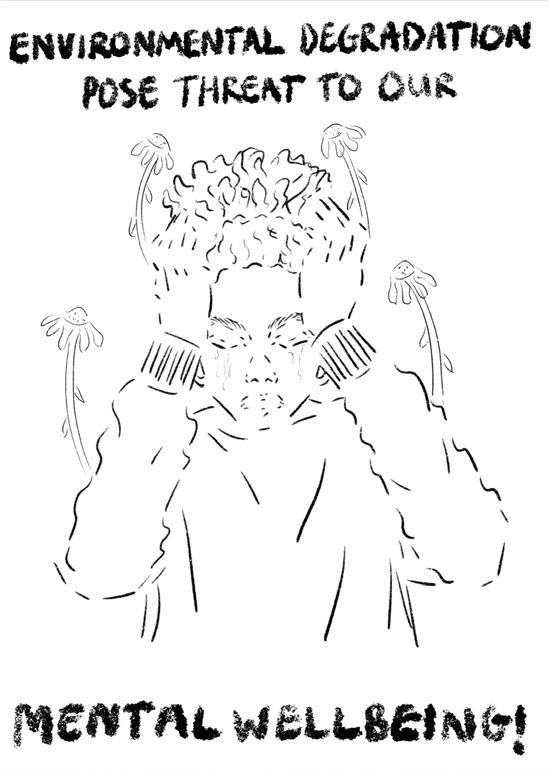
• Impact of waste
• Mental health
• Visual impact

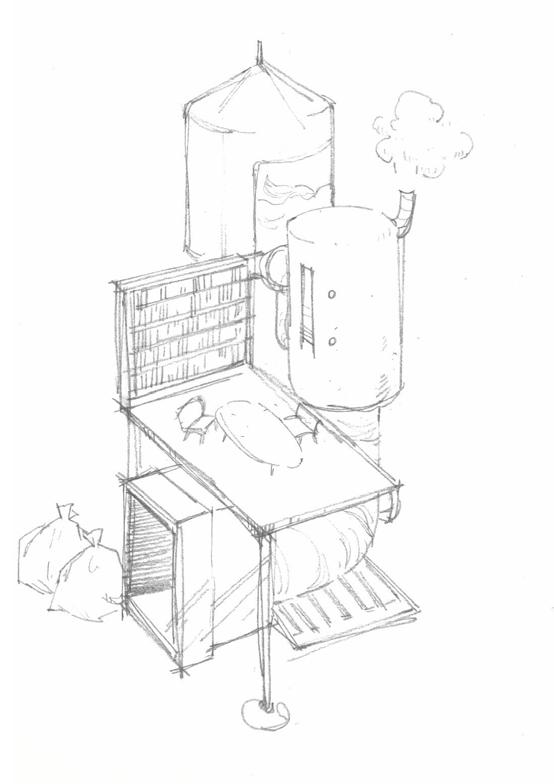 By Zijue Wei
By Zijue Wei
• Solutions of waste
• Waste disposal
• Recycling
 By Folasade Lawal
By Folasade Lawal
• Impacts of waste
• Plastic waste
• Pollution
 By Olivia Hilton
By Olivia Hilton
• Reflective thinking
• Interaction with audiences
We assigned the work of designing posters to illustration and graphic design students. After illustrators finished the drawings on posters, they passed the drawings to the graphic designer who started experimenting with different fonts. Sometimes our graphic designers passed drawings back again, to see whether the text can be incorporated into the drawings. This mode of operation continued until we were working on final outcomes.
We found it an efficient way, since everyone can focus on the field that they are most familiar with and good at, and everyone can contribute to the same outcomes
 By Yingheng Zhang
By Yingheng Zhang
• Impacts of waste
• Ocean pollution
• Animal protection
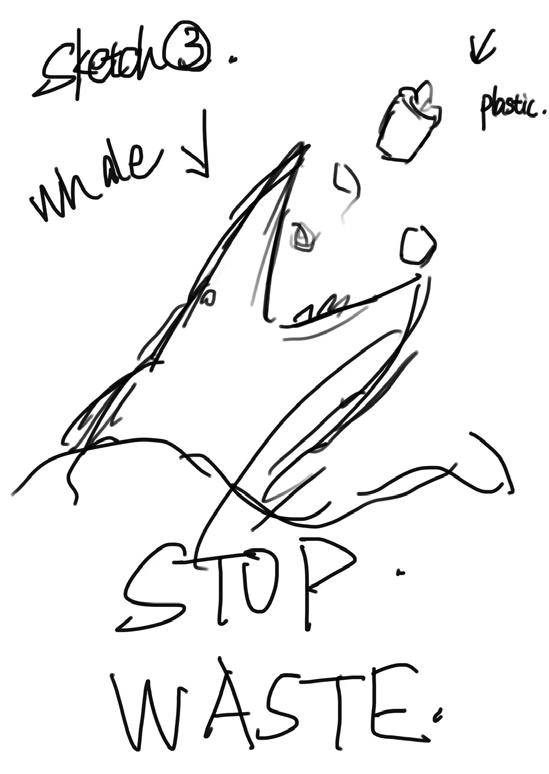 By Yingheng Zhang
By Yingheng Zhang
• Impact of waste
• Ocean pollution
• Animal protection
Also, we could learn from others’ strong points to offset our own weaknesses. Through discussing font selections, learned about different types of fonts and how we can use them, which I was ignorant about before. It provided me with new ideas about graphic design.
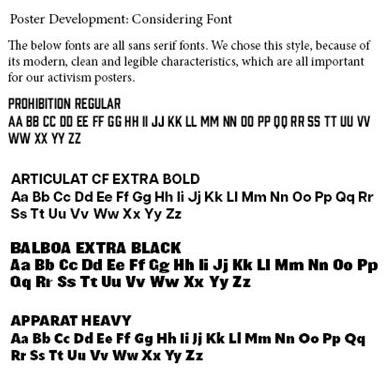



Creating: 3D poster experimentations
How to show contrasts in our posters?
Creating: 3D space experimentations
Where do people see our posters?



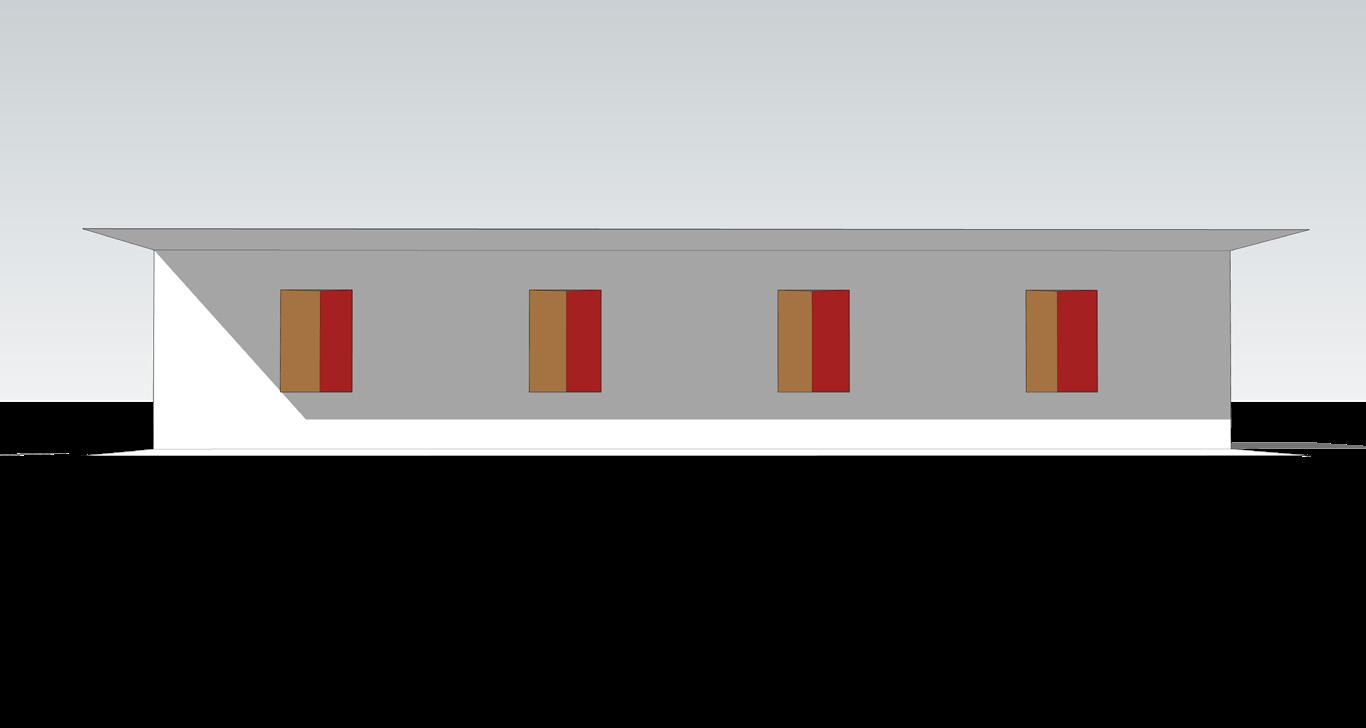


The other design of the 3D poster was inspired by the view-borrowing technique, aimed at showing contrast when interacting with audiences. As audiences walk by, they see different parts of the poster, and the difference between our environment before and after taking action could be noticed.
The design of contrasts was not discussed at the early stage but was picked up again afterwards. There were many factors that made it ignored: lack of communication, unvisualized plans, etc. Therefore, the group did not understand it, and we took a roundabout route on the path towards the final design. realized that to communicate efficiently, especially when talking about something visual, it would be better to sketch it first. It will make our ideas more direct and understandable.
For activism posters, it is extremely important for them to be seen. Consequently, we thought of different ways to exhibit them.
Since our posters were still in thumbnail sketches, the exhibition arrangements were too advanced. However, we were doing this because of an abnormal work distribution. When others are working on posters, the group members who specialize in 3D works had nothing to do, and that was why we spent our time on exhibition set-ups.
In each stage, we should try our best to make sure everyone participates and focuses on their strong fields instead of only distributing tasks to a minority of members.

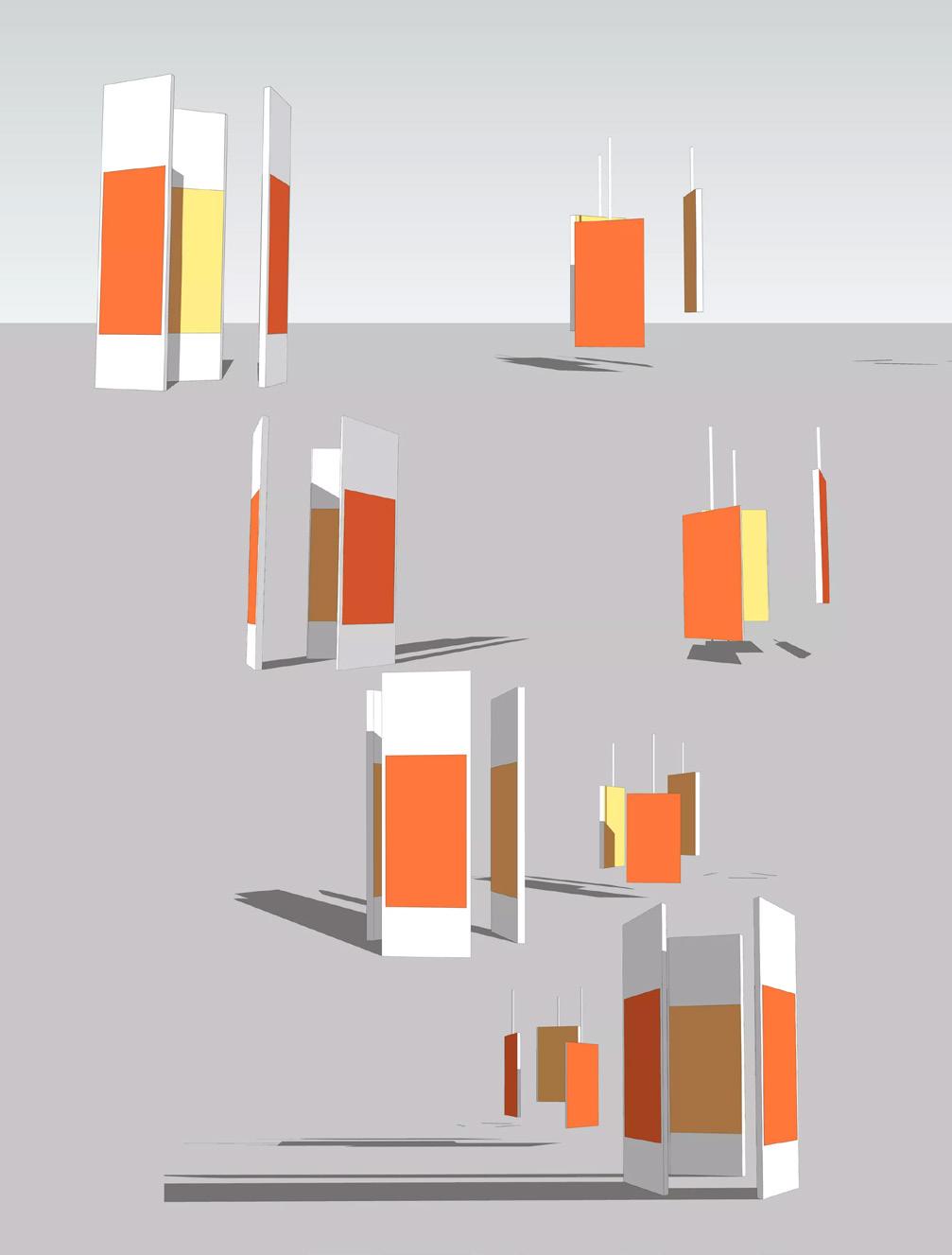 Li
Zijue Wei
Li
Zijue Wei



 View borrowing technique in Suzhou Gardens
3D poster design - Front view by Zijue Wei
3D poster design - Perspective view by Zijue Wei
A space reminds people of nature with mountain shaped roof By Jingyu
Triangular layout enabling audiences see posters from all directions
View borrowing technique in Suzhou Gardens
3D poster design - Front view by Zijue Wei
3D poster design - Perspective view by Zijue Wei
A space reminds people of nature with mountain shaped roof By Jingyu
Triangular layout enabling audiences see posters from all directions
Zijue Wei
WEEK 4 - Develop
Continuing to refine poster designs. Choosing backgrounds and settings for posters in real situations.
Olivia Hilton
Folasade Lawal
Jinyu Li
Alisha Giles
Yingheng Zhang
Issac Prandy
Rahat Ali

Third tutorial:
• Finally decide of target audiences, group name and slogan: the group name is Waste Rebels, making posters for young people in London
• Review posters and making final selections
Group discussion:
• Decide on exhibition set-up: projection on plastic bags instead of conventional printed posters
• Plan to rent equipments for exhibition: projector, laptop, wires, etc.

Reflection: Good coorperation
Since last week, we had tried to solve the problems with work division so that we could all start to work in smaller groups. Each group had a clear goal, and we could engage in our own work.
Work on model plan for the cafe:
• Summarize similarities in public spaces
• Plan movements of customers
• Build digital model
Finalise posters
• Experiment with different layouts, tones and fonts
• Refine details
Work on digital submission
Design logo (not finished till the end of the unit)
Reflection: Problems with online communication
One of the biggest obstacles to our cooperation was online communication. When passing our work to another, we had to send our files through group chat or Padlet, and we did not usually get responses immediately. This made it difficult to work continuously because our different schedules always got in the way. believe more offline work will relieve us from this situation.
How do we
tell
people about waste impacts?

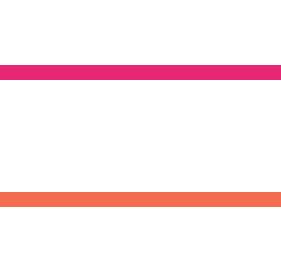


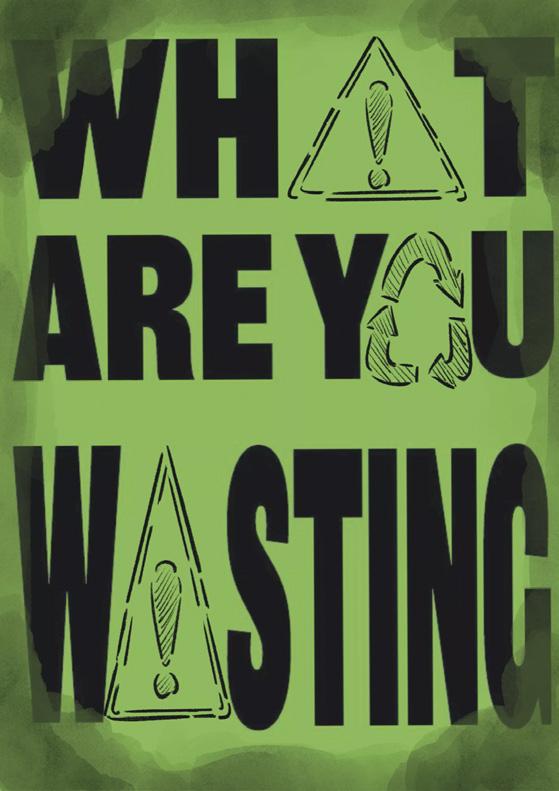

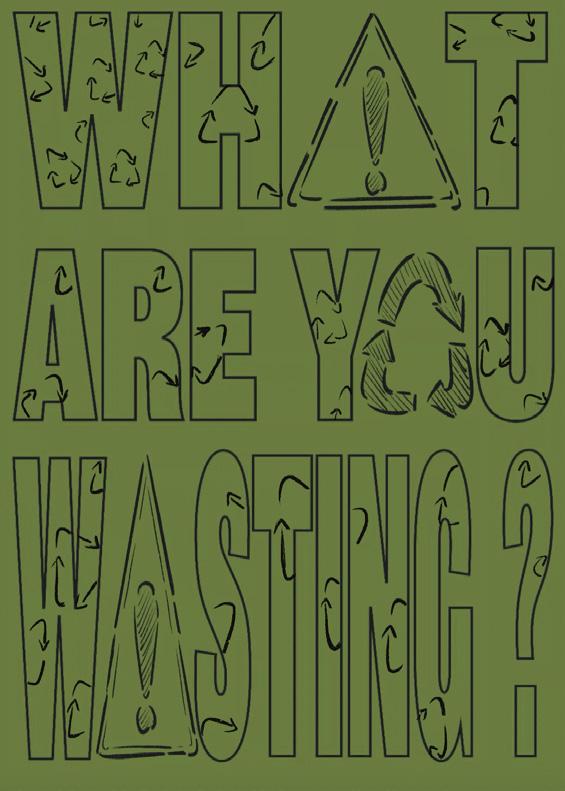







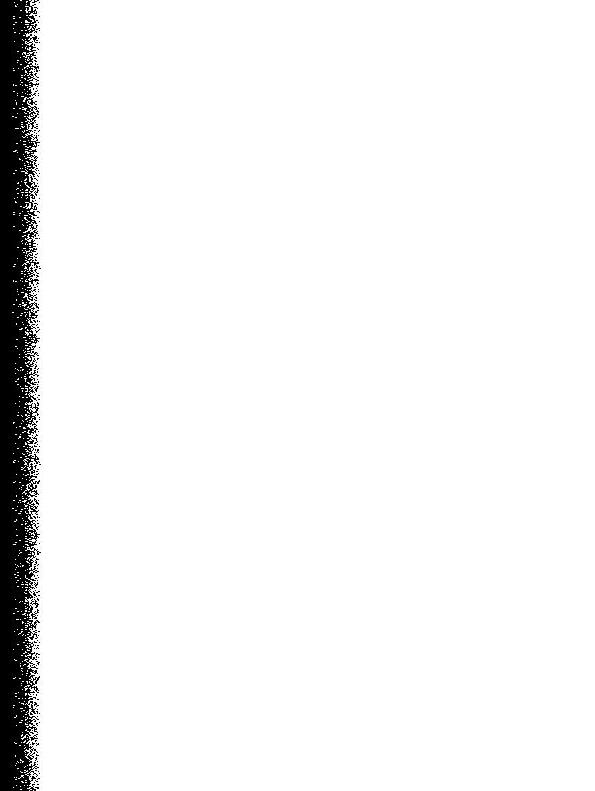
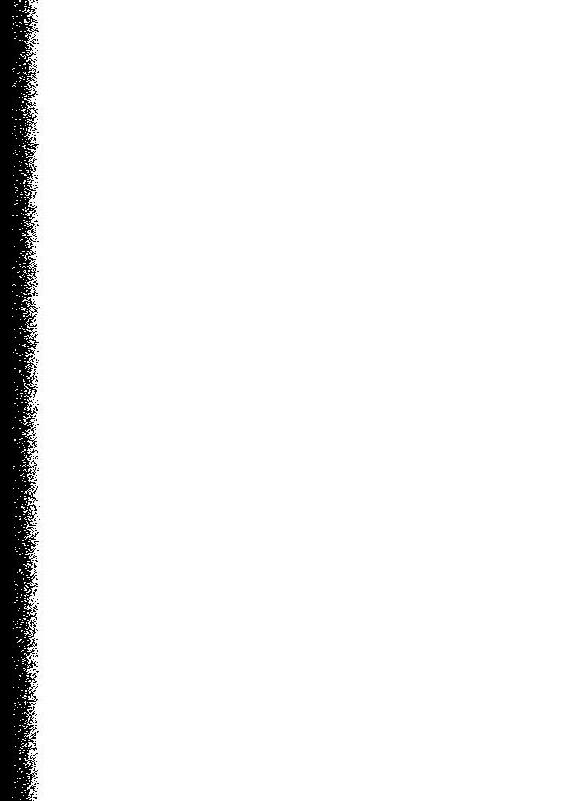


Four themes were selected for the first series of posters:
• Reflecting on ourselves
• Mental health
• Overconsumption
• Ocean pollution
Four members took part in these posters, each working on one poster, with help on fonts from our graphic designer. The outcomes showed our diversity and offered different viewpoints on the waste problem.








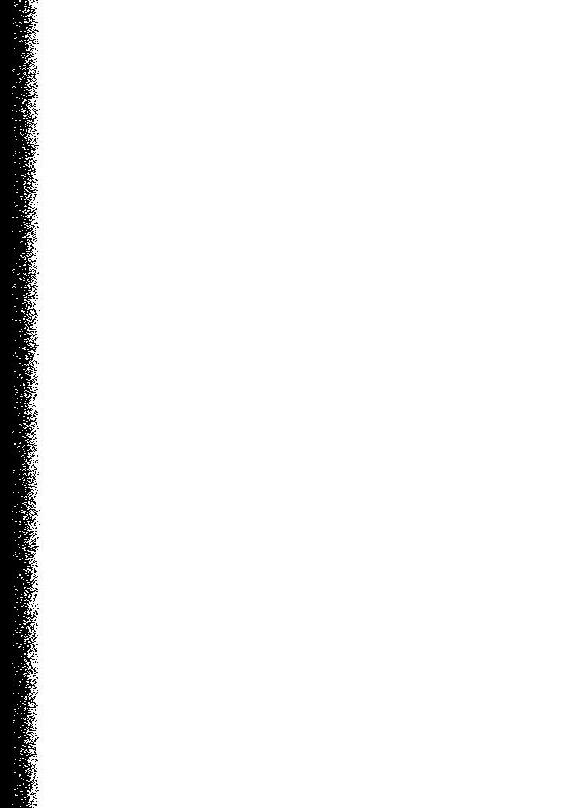




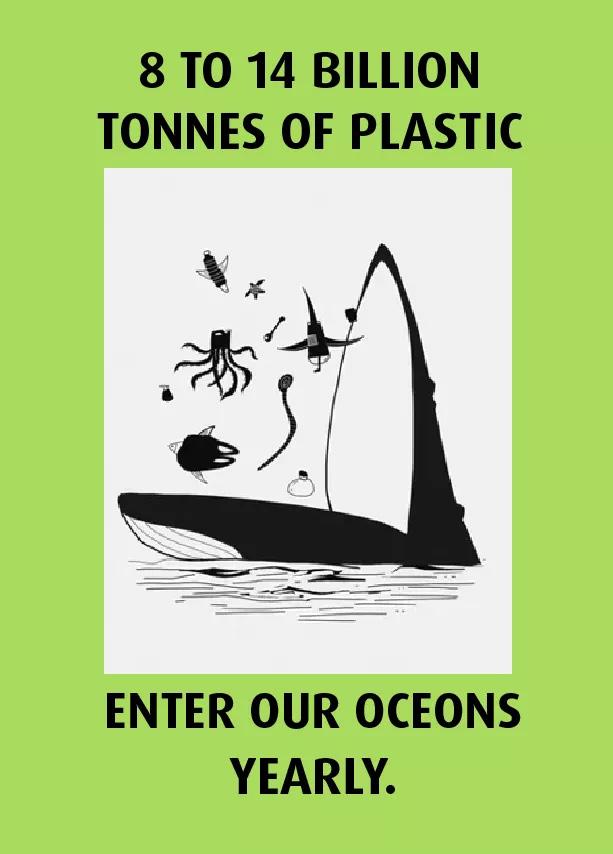
However, the drawings and colours were chosen without any discussion or suggestions from group members and sometimes disagreements were not mentioned.
The progress made at each stage should be shared with others to get responses and comments from them, and we could know the direction of improvements.



Creating: setting up posters
How do we exhibit for the public?



After finishing the first series of posters, we kept going with exhibition set-ups. Combining the two designs from last week, we set up a representative public space—a cafe. In this space, we tried to find the best position for posters in both interior and exterior spaces and planned a micro-model for the exhibition in the final week.
In the process of model making, we insisted on avoiding waste We used recyclable foam board and did not use glue or tape.

Cafe plan and movement analysis
By Zijue Wei Jinyu Li

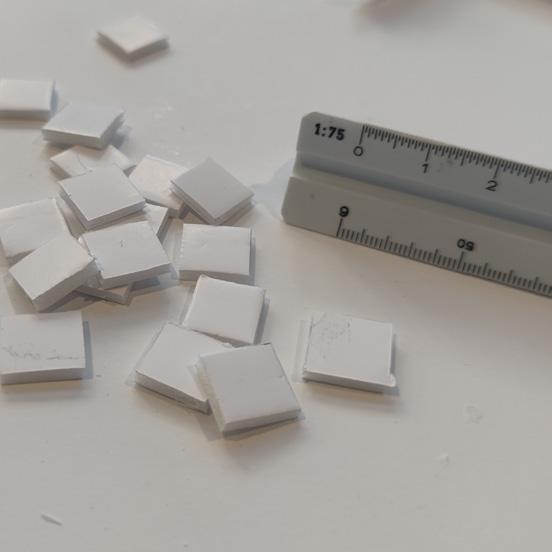
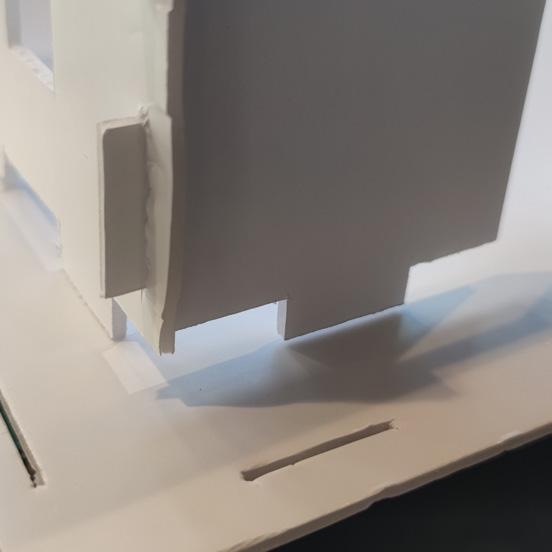 By Zijue Wei
By Zijue Wei





 Digital model made with SketchUp
Digital model made with SketchUp
Zijue Wei
Olivia Hilton
Folasade Lawal
Jinyu Li
Alisha Giles
Yingheng Zhang
Issac Prandy
Rahat Ali
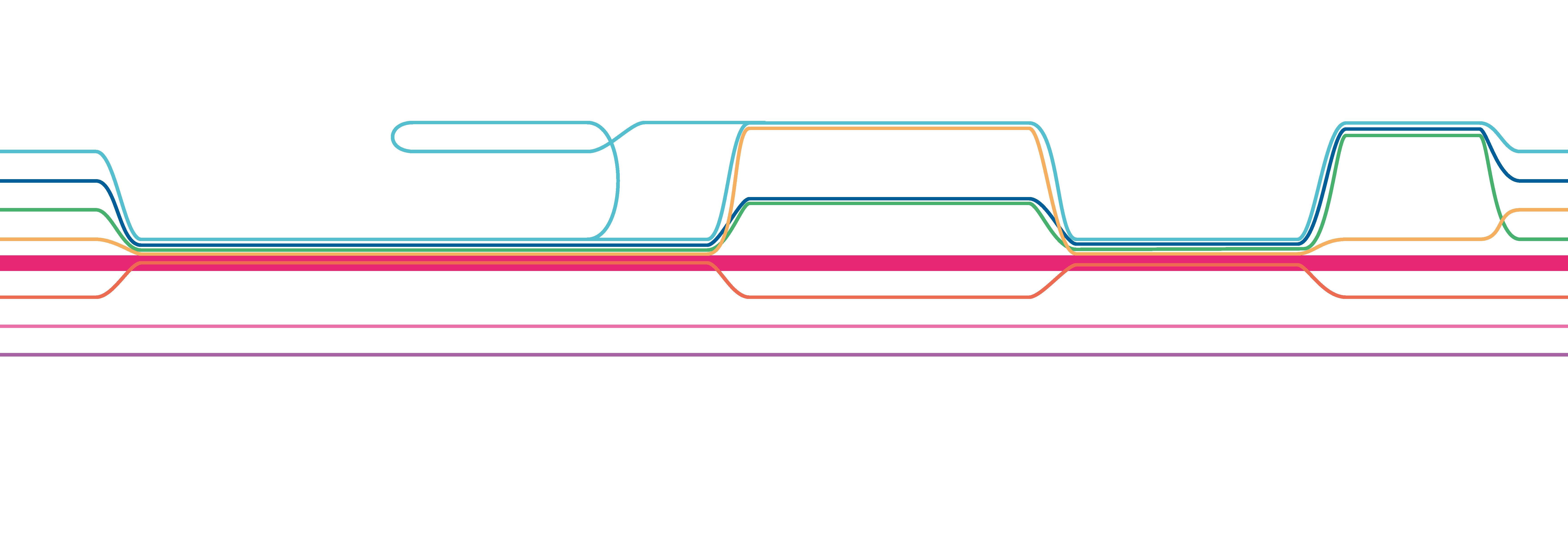
Further communicate with tutor and groupmates about the problems within the group
Give the idea of new series
Fourth tutorial:
• Reflect on previous works, and talk about issues happened in our collaboration
Waste shift poster workshop:
• Make one collage poster together, and discuss future directions
Reflection: Effective communication
We changed a lot this week. We were able to resolve most issues among us by talking about problems that we struggled with in previous stages, raising and clarifying new ideas. There were improvements in our communication skills as well, since we all started to listen carefully to others’ opinions and respect each other. strongly believe that this is the right way to work on a team.
Finalise micro model
Design the second series of posters
Finalise first series of posters
Final online meeting:
Check details of posters and exhibition
Exhibition preparations:
• Rent equipments
• Set up screen
• Prepare slide show
Reflection: Leftover problems
There were still some issues that were too late to refine or resolve at this late stage in the unit’s development. For example, it was too late to refine the topics we chose for the first series. If we can reflect at each stage, we can solve problems faster and avoid leaving them until the last minute.
How did we become a team?





Many issues took place among us in the previous weeks. We made some decisions without any communication, ignored some group members’ ideas, and our work went off the theme. There were disagreements and dissatisfaction. At that moment, realized the problems were gradually posing a threat to our collaboration. talked with some other group members and our tutor, and we agreed that we needed to change.
After discussion with the whole group, we decided to have a group workshop to create a collage poster, and we needed to think back at the question we gave at the early stage of this unit:
What are you wasting?
By reflecting on this question, we found that it was not enough just to mention the impacts of waste—we had to inform people that there are ways to change and that we can have a better future if we take actions. Responding to the question, “What are you wasting?” we found the answer:
We can be the solution.
We decided to add one more series of posters in response to the previous ones we made. The new series would be about the solutions to the impacts of waste we discussed. These posters could show a strong contrast with the former ones, and tell people what to do to help.
By doing the group workshop this time, we made the most important step in this unit. This was the first time we really worked together in person, and when making this poster, we had in-depth communication about our theme, our concept, and our designs. Finally, there was agreement in our group about what we were doing and what we should be doing.


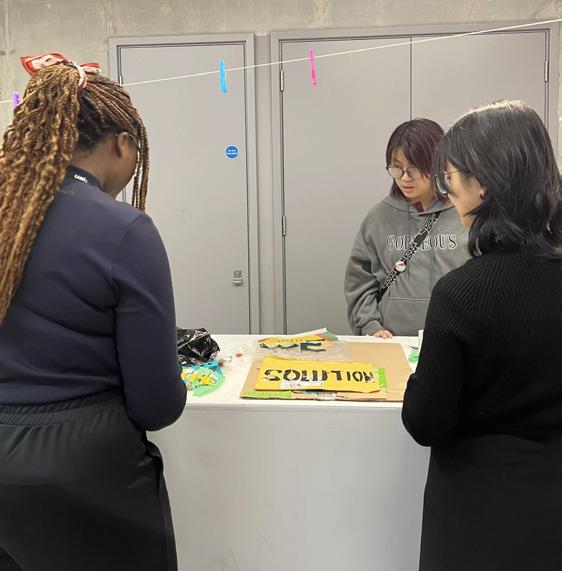
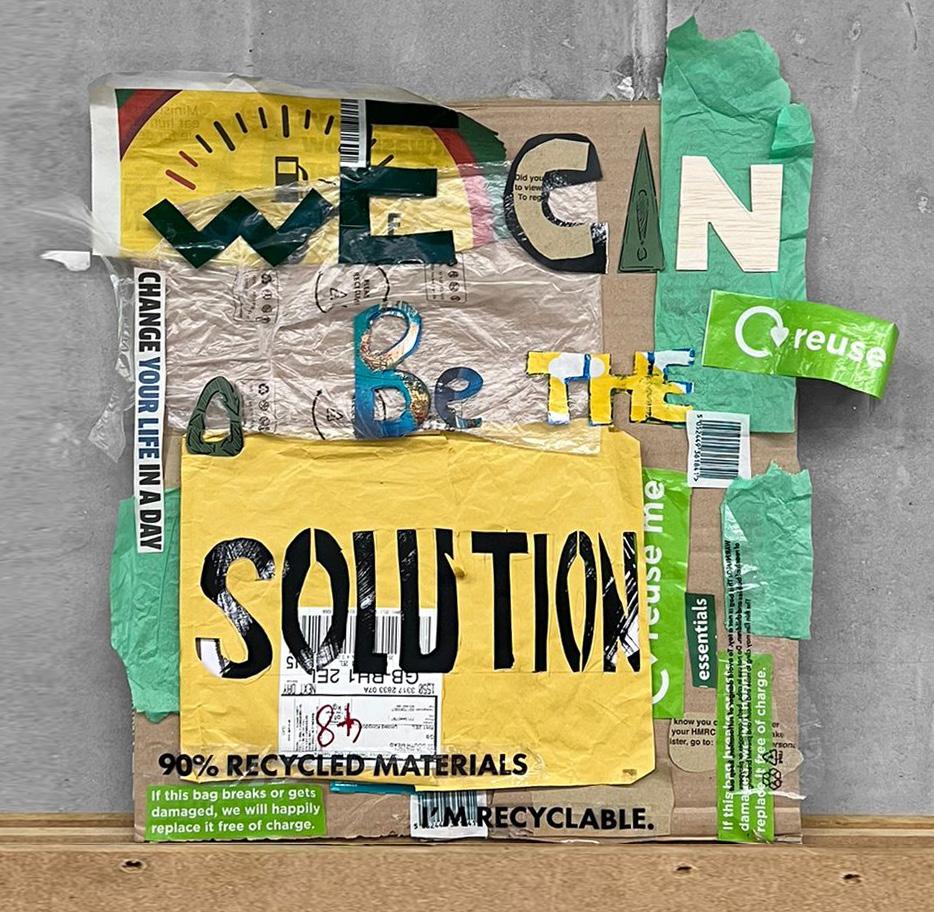



Creating: second series conceptualization
What can we do to reduce waste?
Creating: colour palette
What kind of feeling are we giving with colours?



 By Jinyu Li
By Jinyu Li
 By Zijue Wei
By Zijue Wei

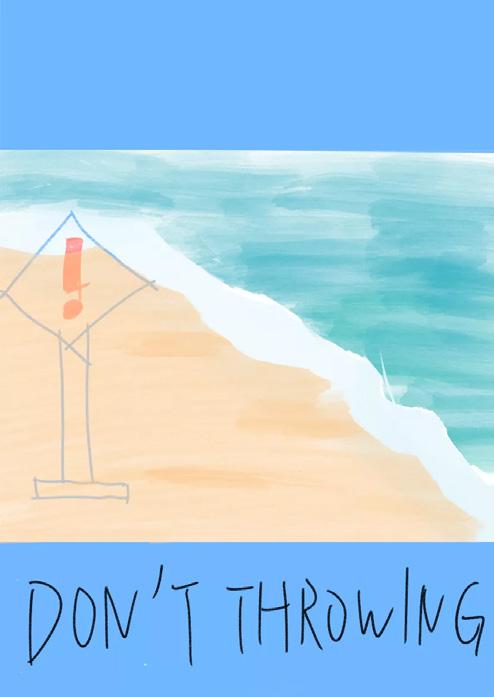
“They can be viewed as objects, or things, for example, cellphones, leafy greens, and plastic straws. Their journeys can be followed from ‘birth’ to afterlife. And they are waste streams containing items of value (gold and metals, recyclable plastic, compost), and risk (mercury and dioxin, contaminated foodstuffs).” (O’Neill, 2019)
As the general public, we still have many ways to reduce waste. We can prevent waste before it is produced and treat existing waste properly.
Corresponding to the first series of posters, the new series is mainly about:
• Maintaining a clean and nice environment
• Avoiding overconsumption by careful thinking
• Preventing rubbish from going into oceans

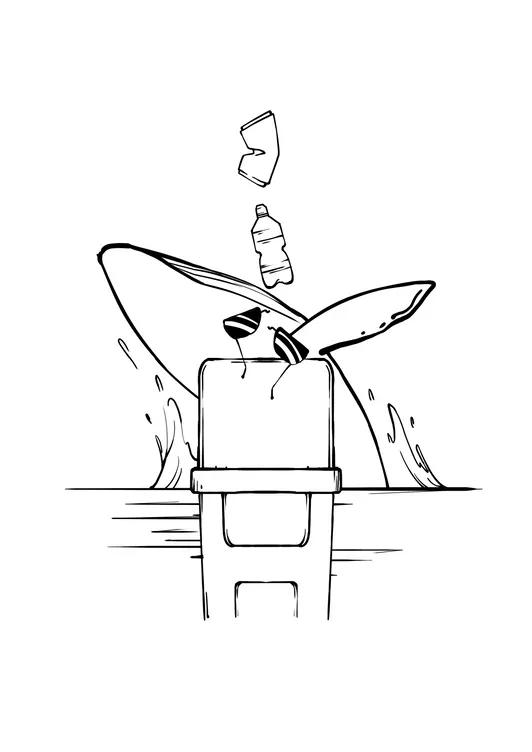

We learnt from the mistake in colour selection of the first series of posters. When choosing colours for the new series, we thought carefully and discussed fully the impressions of different colour sets. We finally chose the couple consisting of green and blue. Dirty green represents what we were not doing enough to protect the environment. Then light blue is for the second series, bringing in a bright and positive feeling towards waste solutions and subconsciously motivating people to adopt these habits.
The way we discuss has changed completely since the group workshop, by starting to share our progress and work in the group chat so that we could get responses immediately. We all knew what others were doing, and the feeling made us more aware of being on a team.





What do we tell people about waste solutions?














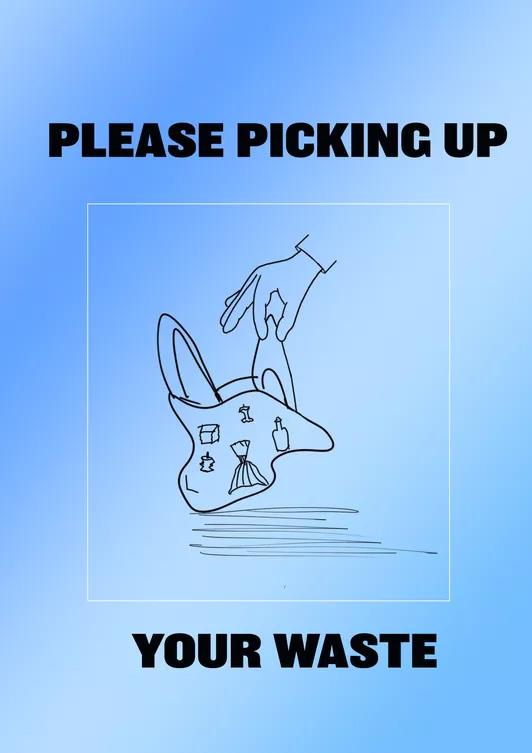
















Where are our posters in public spaces?




While working on this micro-model of the cafe, we thought carefully about how images may affect audiences in a busy environment and how to make a representative space that covers most situations. For example in this model, we thought about different modes on communication among cafe customers and staffs, and the movements of people in the space. And we shared these knowledges with other group members who had never been working on a spatial project before. I believe these knowledge will inspire them in the future, when they produce 3D works or visualized art forms aim at general public.
After photographing this model, it was deconstructed and collected in a plastic bag. Throughout this unit, we insisted on avoiding waste production. We created digital posters and communicated online. When we had to use paper or any materials, we collected the waste we produced, and they were also kept in plastic bags for our exhibition.
 By Zijue Wei, Jinyu
By Zijue Wei, Jinyu



Presenting: setting up projection for exhibition
What did we do with the waste our group produced?



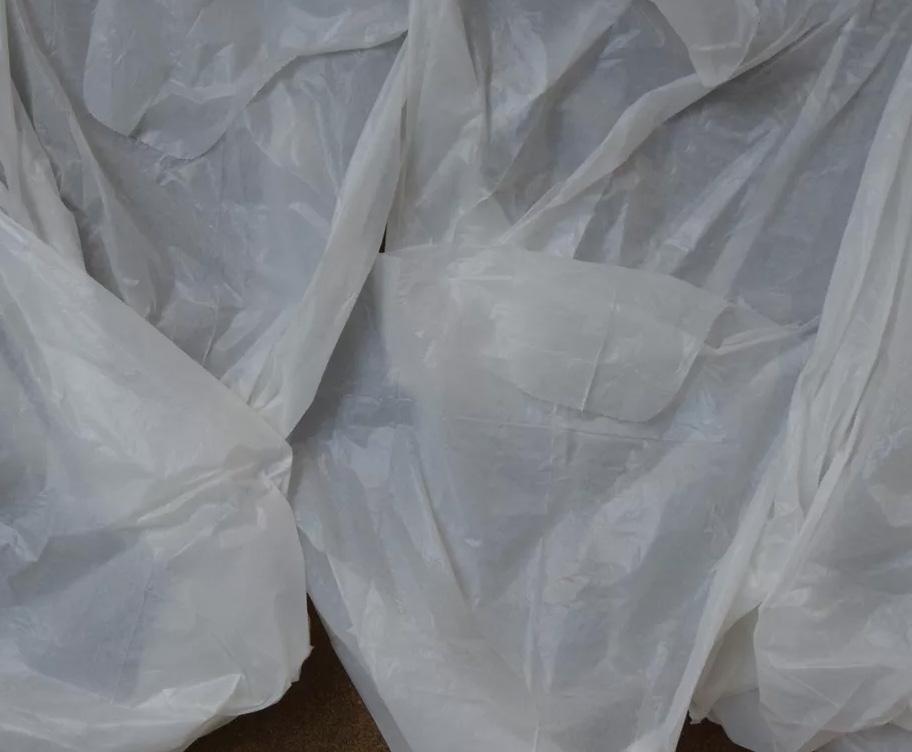 By Zijue Wei, Jinyu Li
By Zijue Wei, Jinyu Li
 By Zijue Wei Jinyu Li
By Zijue Wei Jinyu Li


All the posters were done, and it was time to begin our exhibition set-up. As we collected waste from this unit, our first idea was to project posters onto these plastic bags to give an idea about transforming our lifestyle to reduce waste. We put plastic bags filled with waste on the wall to form a white screen for projection.
Nevertheless, the plan went wrong when setting up in the exhibition space. We did not experiment with the projection screen beforehand, without realizing that the projection could not show on these plastic bags until one day before the exhibition. We had to change our plan to projecting posters on the wall with plastic bags next to them.
Experimenting beforehand is extremely important when trying something we have never done before. It will give us enough time to change our plan and make sure we do not drop the ball at the final moment.



Setting up the projection and taking part in the exhibition.
Zijue Wei
Olivia Hilton
Folasade Lawal
Jinyu Li
Alisha Giles
Yingheng Zhang
Issac Prandy
Rahat Ali
Exhibition:
• Set up equipments
• Visit exhibition
• Collect works and equipments after exhibition




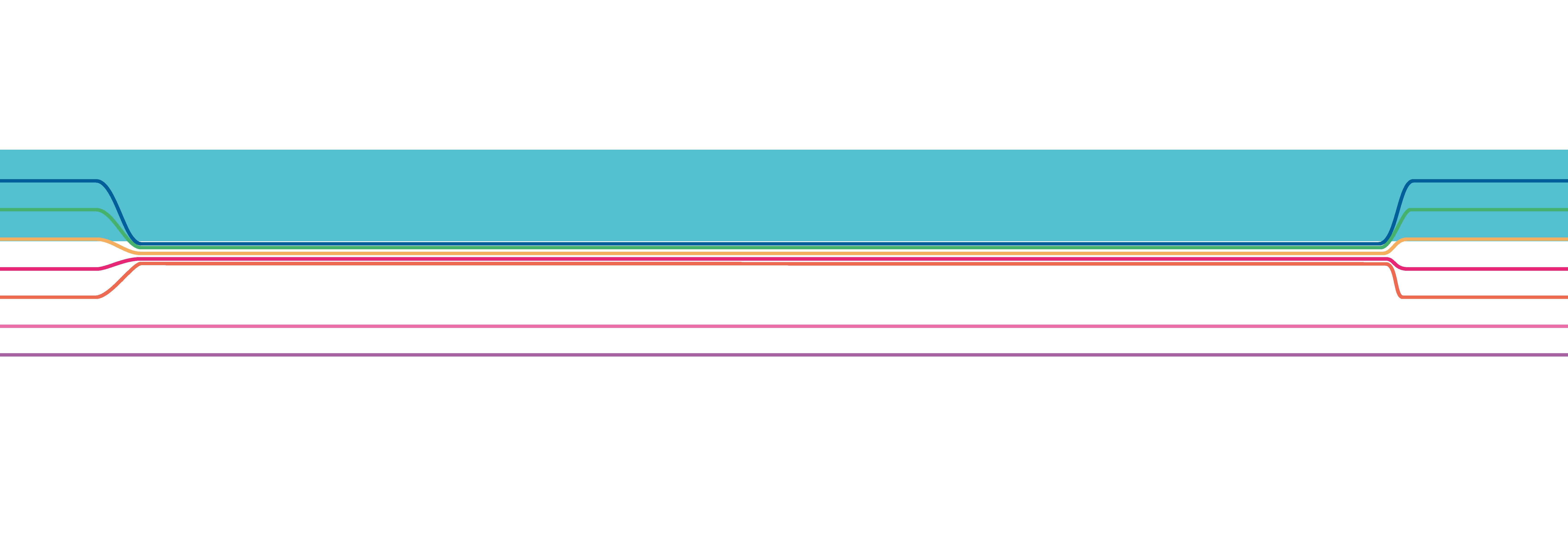
Presenting: selecting posters for exhibition
What would you see at the exhibition?





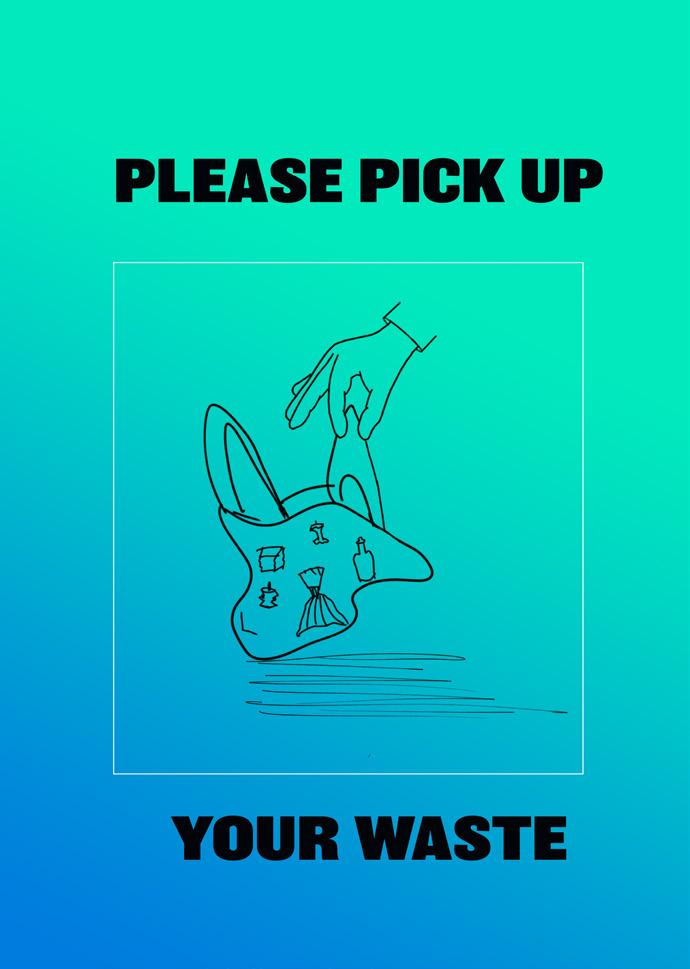

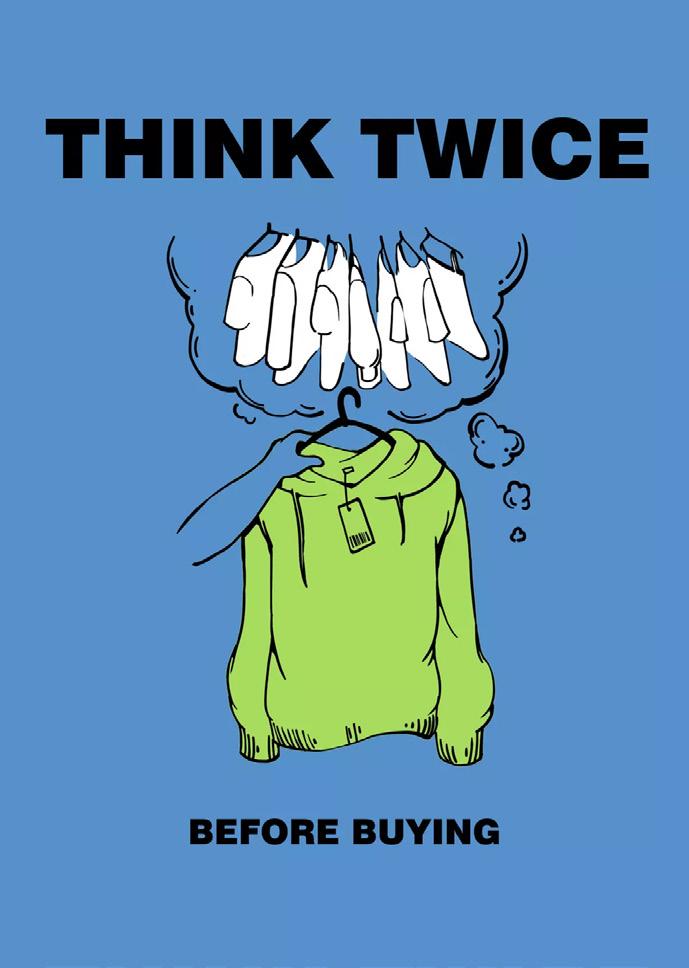


Final poster selections for exhibition


What would you see on our Instagram?


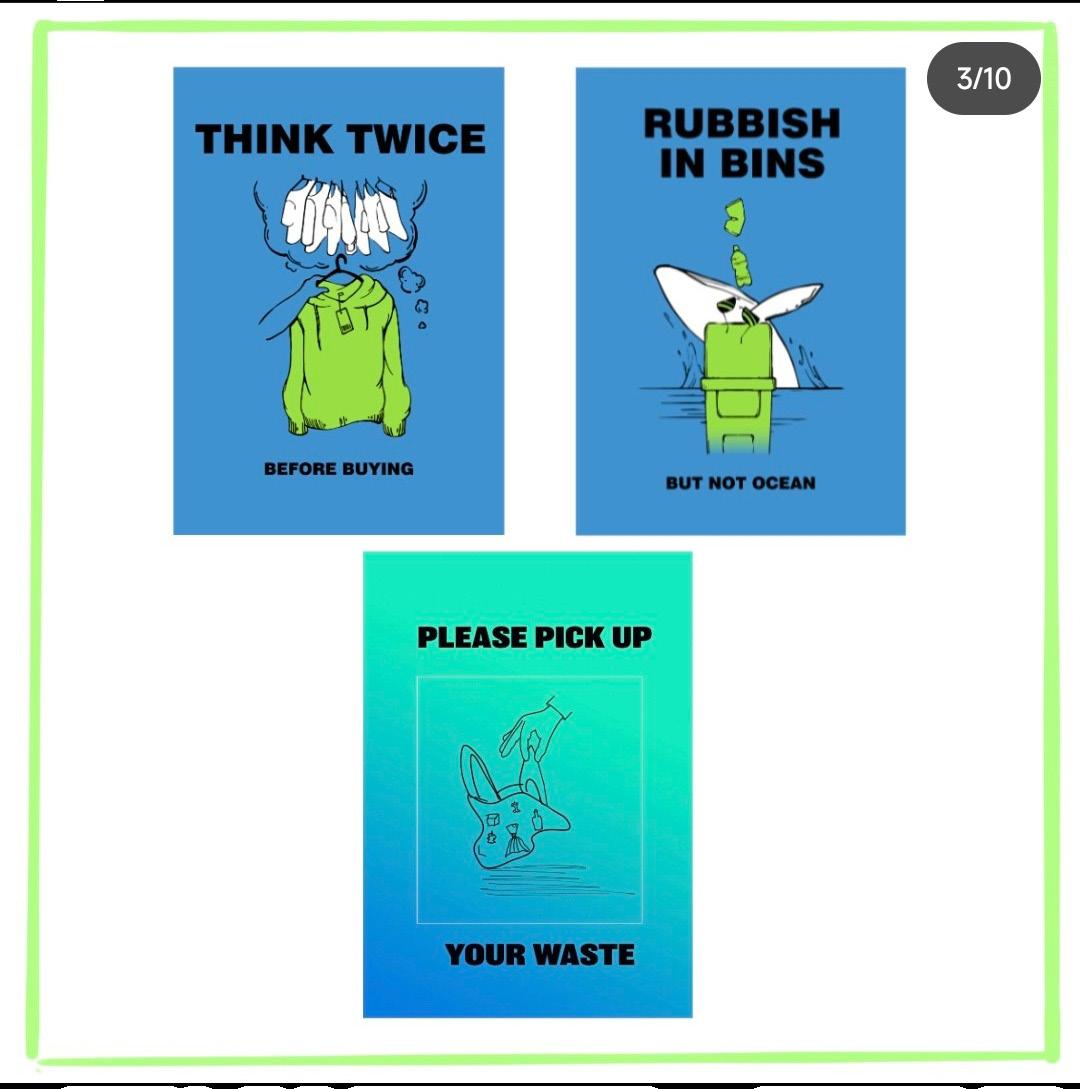

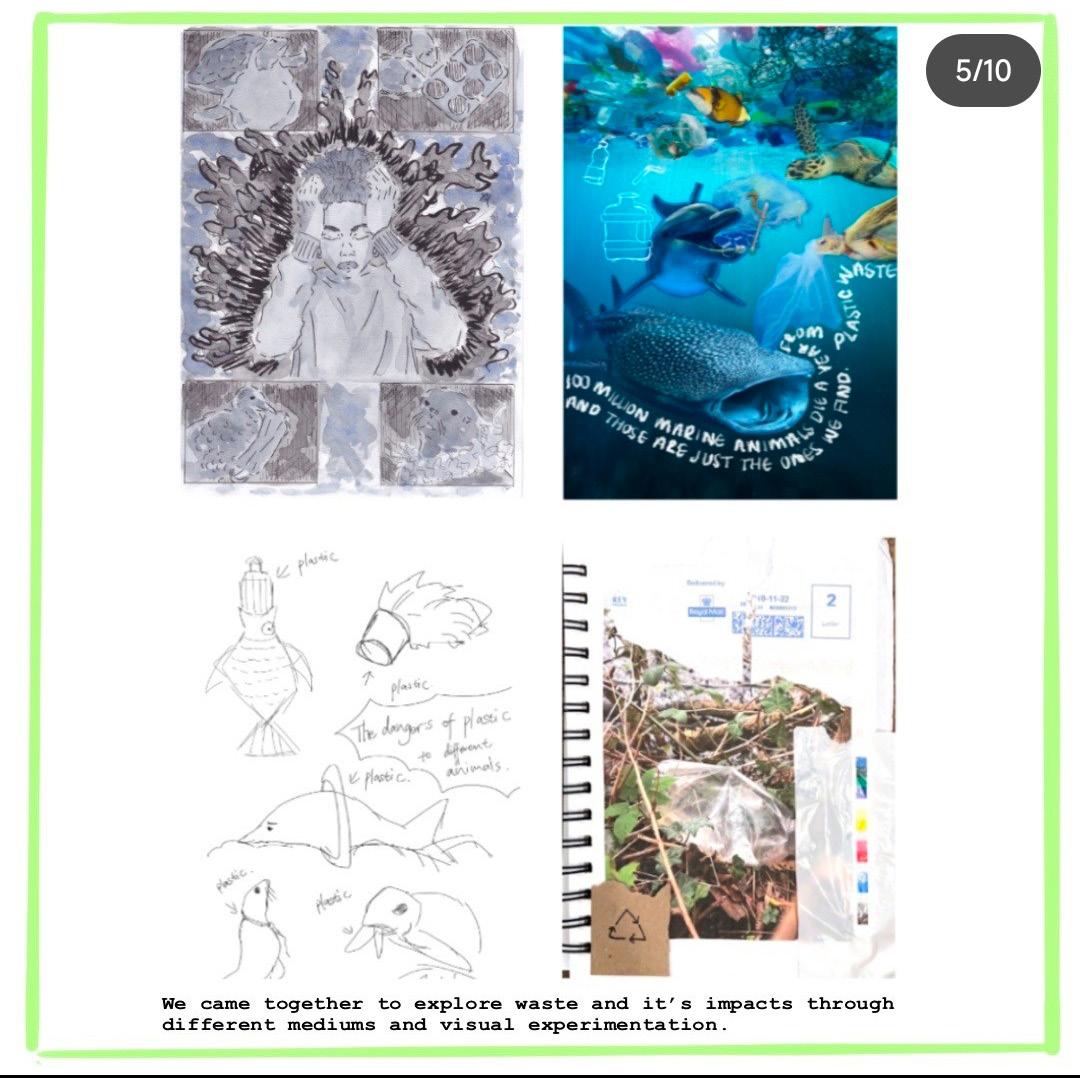
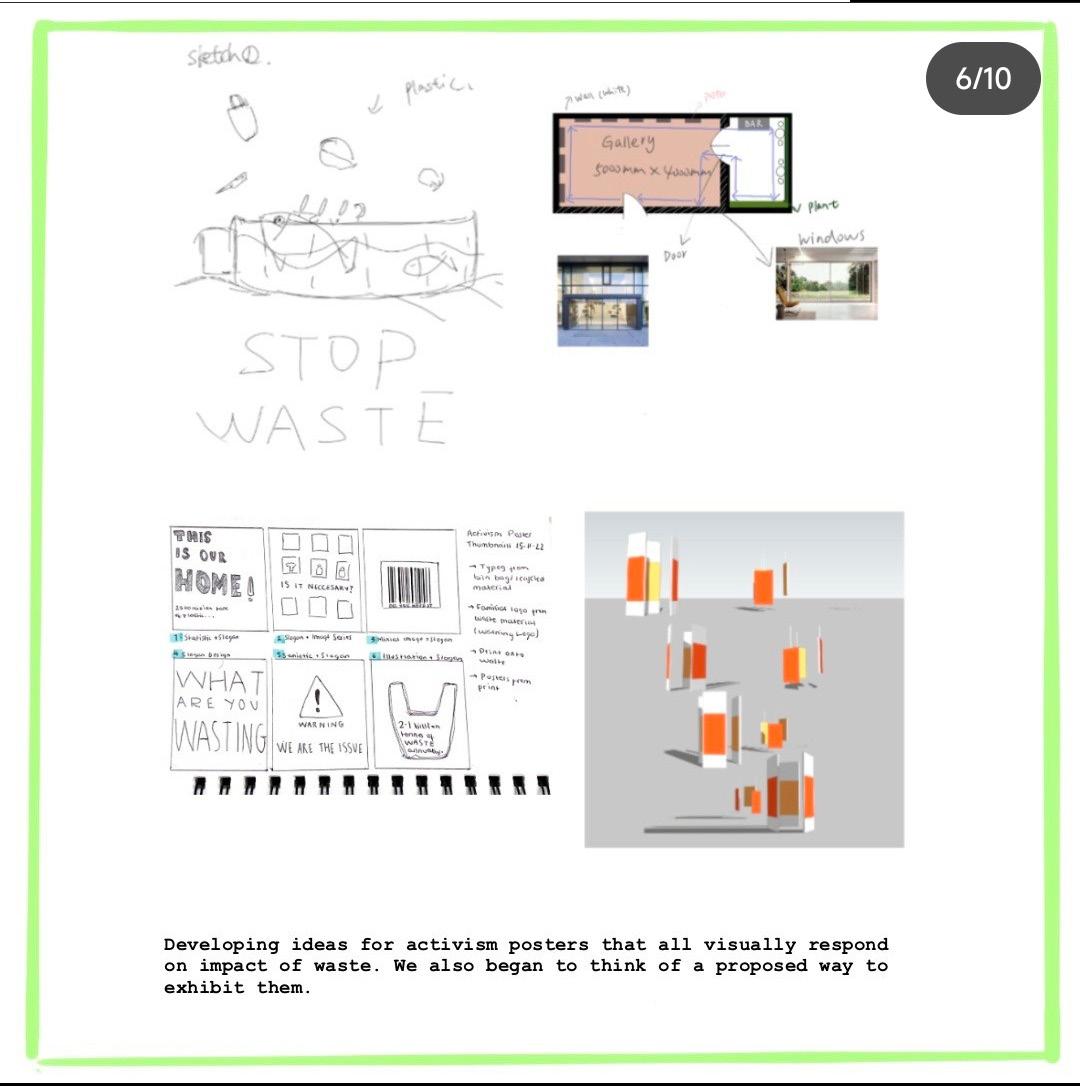

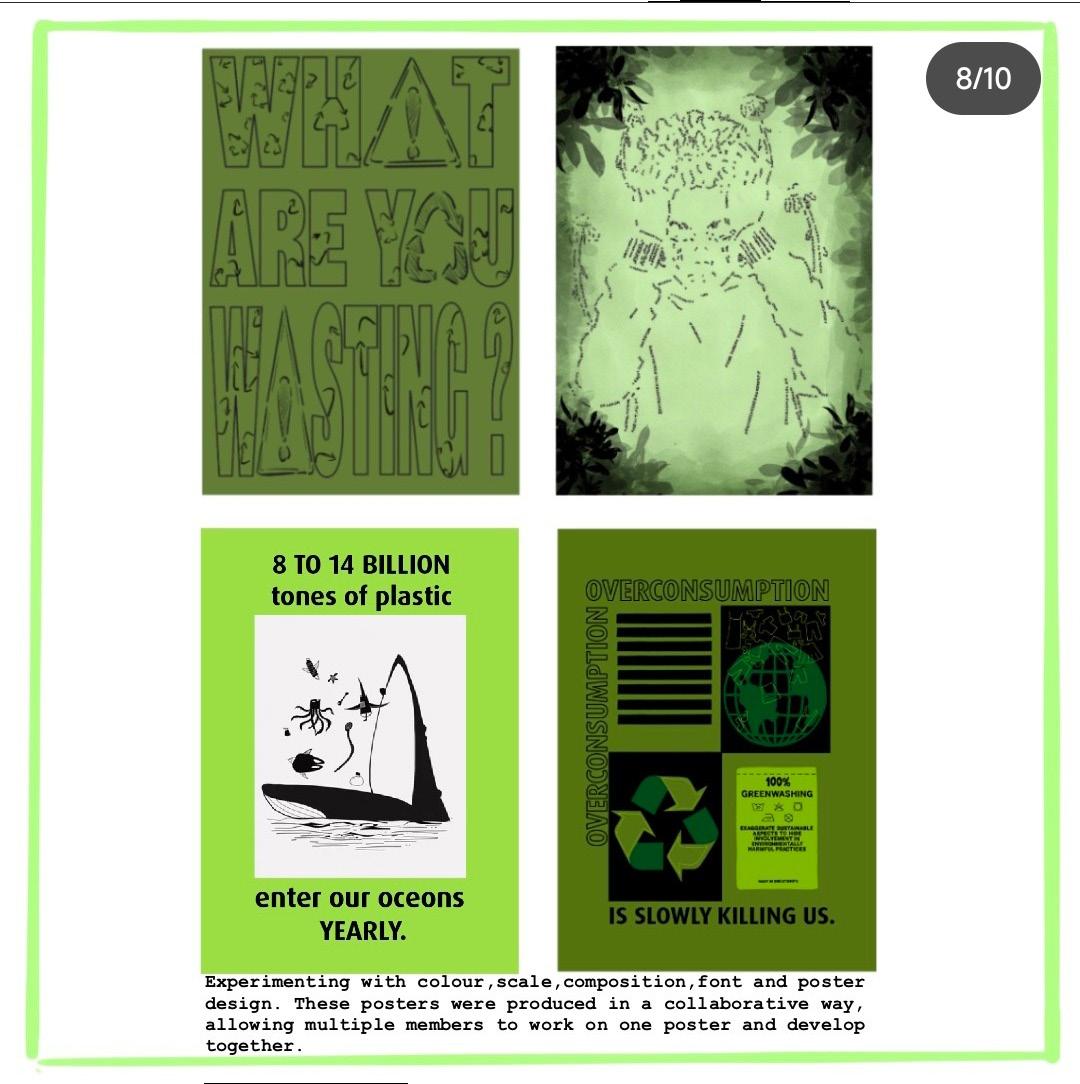




24.90%
Reflecting: group statistics-overall
How much did we engage in this project?
24.72%
86.28% of the work was done by only 3 members, which is not ideal for a team. Meanwhile, 4 members did less than 5% of the work. We got our satisfying results thanks to extra work done by a few active members.
36.66%
6.97%
Weighting method: (2*padlet uploading times+WhatsApp speaking times)/ total e.g. (2*132+297)/2253=24.90% More accurate data is shown on page 52.
The statistic results does not fully represent our contribution in this unit, but can be considered a reference. There is some data that I was unable to access or remember, such as attendence and accurate time of communication. Only most representative data were selected to make this diagram.



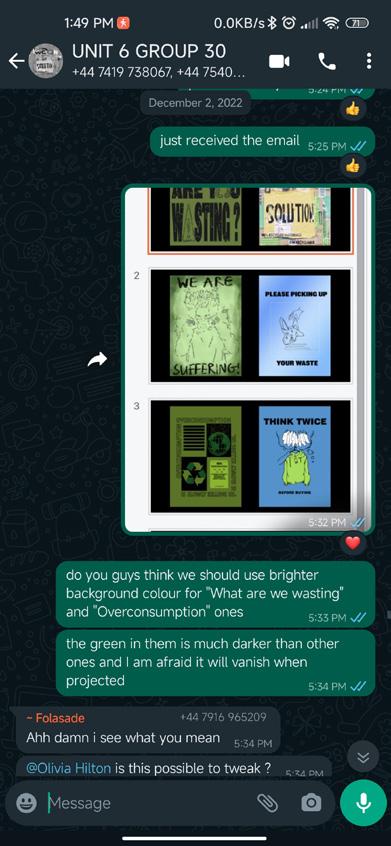


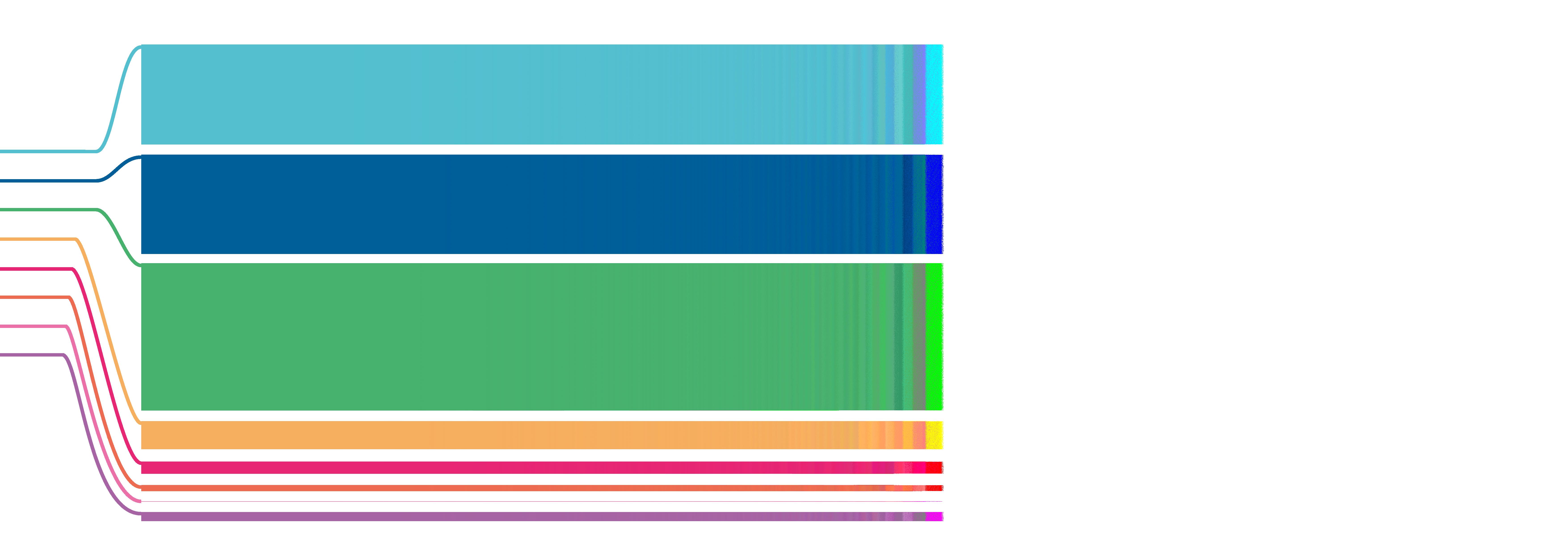

How much did we do?
How many times did we talk in WhatsApp group chat?

Zijue Wei
Olivia Hilton
Folasade Lawal
Jinyu Li
Yingheng Zhang Alisha Giles
Issac Prandy
297 times
How many times did we upload on padlet?
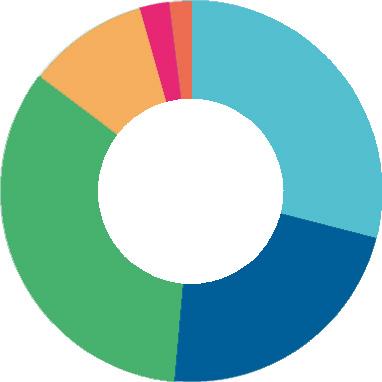
During the unit, not everyone participated. Some people gave many ideas on all different aspects, and some people were too shy to talk.
What I found useful was communication between two or three group members to clarify and evaluate ideas before presenting them to the entire group. When more than one person understands us, it not only encourages us to speak more but also leads to fewer misunderstandings.
times times
times
How much time did we spend online and offline?

We made the most progress during tutorial and workshop times. When we met each other in person, we could put ourselves into the discussion and exchange ideas directly. But in online meetings, we were simply sharing our progress without further analysis and dissection of ideas, and we just stayed where we were.
The group workshop to make the waste shift poster helped us out. It reminded us that we have to make progress together to become a team.
“...it is critical that all involved entities work interdependently and contribute sufficiently towards reaching their joint aims.” (Wendy L. Bedwell, 2012) When a group is working on the same thing especially offline, we have a clear goal and truly participate. In this situation, we make progress more likely.
Online Offline (workshops)
Offline (tutorials)
Around 10 hours
Around 6 hours
52 53

Reflecting: summarizing collaborative experience
How was our collaborative experience?
Us
From
We had misunderstandings and estrangements over the last six weeks. But luckily, we made through it thanks to the serious communications and endeavour of our groupmates.
It was a memorable experience that continues to remind me of how we can solve interpersonal problems and communicate effectively. What I understood most deeply in this unit is that we have to speak and listen so we can solve problems rather than letting them go, and making them grow into bigger disagreements without a sound.
Meanwhile, despite the fact that we were not doing enough, we can still analyze the collaborative experience further and extract some helpful points for our future study.
Reflecting: self reflection
What did I learn from this experience?
Collaboration skills:
Communicating more effectively with visualized diagrams or sketches:
In the design field, in particular, sometimes it is hard to explain an idea verbally. It will help a lot if we can do some sketches or models about a concept, which makes our concepts more understandable and direct.
More listening and speaking:
“We posit that collaboration cannot be one-sided. Rather, it requires active, mutual engagement in the collaborative process at some level from all involved parties (e.g., Longoria, 2005; Tucker, 1991).” (Wendy L. Bedwell, 2012) Collaboration is established on mutual understanding. By giving our own ideas and listening to others’ ideas, we understand each other better, and it is also easier to gather information around and produce better outcomes.
Supporting and encouraging each other:
When a group member is unconfident with their ideas or too shy to speak, what we can do to help is encourage them to talk or assist them in presenting their ideas in front of the group. This will help to maintain strong bonds among group members and boost the speaker’s confidence.

Reflecting: self reflection
What will help with the collaboration next time?
Techniques and design knowledge:
Graphic design skills:
• How to identify and use different fonts? e.g. sans serif and serif
• How to embed different textures on a plane?
• How to lay out text on a 2D plane?
Online working:
• How to share files online? e.g. Teams sharing, Onedrive and Padlet
• How to organize an online meeting?
Questioning and being questioned:
When we do not understand someone’s idea, be brave and ask. Misunderstandings will be less likely to happen if we can all clarify our ideas. Meanwhile, we must get ready to be questioned, since we may make mistakes without realizing or not explain our thoughts clearly. It is a good chance to get familiar with groupmates as well.
Working together, offline if possible:
“Where before, we could use physical spaces to encourage collaboration, such as breakout areas and dedicated meeting rooms, we need to be a little more creative in how we ring fence space for collaborative planning and thinking. Think about creating a dedicated brainstorm channel, away from other communication spaces for this purpose.” (Kohler, 2020)
Online working is extremely different from offline working. When having an online meeting, people do not always show their faces, and it is hard to know their reactions. Working face-to-face on the same assignment will help a lot. We communicate while working, and we can reach a consensus about what we should do sooner.
More chatting in leisure time:
A group working together does not have to work together exclusively. “Probably one of the first things you should do after introducing yourselves is to go somewhere where you can talk to one another in a relaxed way. Go and have coffee or a meal together. Talk about things other than work. It’s all part of creating a ‘social infrastructure’, a network of human relationships that will ‘underpin’ your project work.” (Levin, 2004)
Even though the group is coorperating, it is not just about working but also knowing the personalities of each member. We can talk to and cope with our group members better, if we have a basic understanding of their characteristics.
Using some website to learn about some climate problem. These problems affect people's activities and the earth. And make the mind map to mention idea.
Starting draw the floor plan about “cafe and

Shared timeline file
By Zijue Wei, Jinyu Li, Folasade LawalThis timeline file was filled out by group members to indicate what we did in each stage of the unit. This timeline is for reference.
However not all members participated in this file, so I also referred to our padlet and groupchat for more working records.
Bibliography

@r/gymsnark, 2021. nyone else bothered by influencers’ overconsumption?. [Online]
Available at: https://www.reddit.com/r/gymsnark/comments/ nw7vfn/anyone_else_bothered_by_influencers/
[Accessed January 2023].
拙政园, 2020. 借景 拙政园的精妙所在. [Online]
Available at: https://www.sohu.com/a/424331834_120083328
[Accessed November 2022].
Anon., 2017. Waste Management and Recycling. [Online]
Available at: https://www.pgpaper.com/waste-paper-recycling/
[Accessed January 2023].
Anon., 2018. Plastic pollution: Images of a global problem. [Online]
Available at: https://www.bbc.co.uk/news/science-environment-44215882
[Accessed November 2022].
Anon., 2021. 8 illustrations that show a hopeful climate future (PS: but we need to act now!). [Online]
Available at: https://ideas.ted.com/how-effective-climate-change-images-impact-emotions-and-behavior/
[Accessed November 2022].
Anon., n.d. Good on You. [Online]
Available at: https://goodonyou.eco/
[Accessed November 2022].
Anon., n.d. White Dragon Paper. [Online]
[Accessed January 2023].
CFI Team, 2022. Circular Economy. [Online]
[Accessed January 2023].
Eco•Age, 2019. Wardrobe Crisis Podcast: What To Do About Overconsumption?. [Online]
Available at: https://eco-age.com/resources/wardrobe-crisis-podcast-kate-fletcher-overconsumption/
[Accessed January 2023].
EPA, 2022. What is a Circular Economy?. [Online]
Available at: https://www.epa.gov/recyclingstrategy/what-circular-economy
[Accessed January 2023].
Josephson, A., 2022. How to Sell Electricity Back to the Grid.
[Online]
Available at: https://smartasset.com/mortgage/sell-electricity-back-grid
[Accessed November 2022].
Kirste, F., n.d. Zer0 Waste. [Online]
Available at: https://www.fridtjofkirste.de/illustrations?pgid=jzwebfk8-e466d884-836f-4d24-9550-fbef7853c602
[Accessed November 2022].
Kohler, L., 2020. The psychology of effective collaboration. [Online]
Available at: https://scarlettabbott.co.uk/topic/psychology-of-effective-collaboration
[Accessed January 2023].
Levin, P., 2004. Student-Friendly Guide: Successful Teamwork. s.l.:s.n.
Morgan, I., n.d. Think Before You Spend: 5 Questions To Ask Yourself Before You Buy. [Online]
Available at: https://www.lifehack.org/articles/money/think-before-you-spend-5-questions-ask-yourself-before-you-buys.html
[Accessed January 2023].
Noel Cass, K. L. A. J. A. M. B. R. L. M. M. C. M., 2022. Curbing excess: high energy consumption and the fair energy transition, s.l.: s.n.
O’Neill, K., 2019. Waste. s.l.:s.n.
Padula, L., n.d. BUG BOUNTY | Data and Society. [Online]
Available at: https://www.lilypadula.com/#/data-and-society/ [Accessed November 2022].
Ravenhall, L., 2019. How litter harms our wildlife. [Online]
Available at: https://www.forgerecycling.co.uk/blog/how-litter-harms-our-wildlife/#:~:text=Cans%2C%20which%20animals%20 look%20inside,which%20also%20results%20in%20death).
[Accessed November 2022].
Silva, C., 2022. The Science Behind Why We Follow Influencers — And How It Leads To Overconsumption. [Online]
Available at: https://in.mashable.com/digital-culture/41172/thescience-behind-why-we-follow-influencers-and-how-it-leads-tooverconsumption
[Accessed January 2023].
Souza, E., 2019. Zero Waste in Architecture: Rethink, Reduce, Reuse and Recycle. [Online]
Available at: https://www.archdaily.com/928391/why-flexibility-and-material-reuse-are-key-aspects-of-sustainability
[Accessed November 2022].
Wainwright, O., 2021. ‘This is the age of waste’: the show about our throwaway addiction and how to cure it. [Online]
Available at: https://www.theguardian.com/artanddesign/2021/ nov/01/waste-age-exhibition-design-museum
[Accessed November 2022].
Waste Rebels, 2022. Collaborative Research/Development on WASTE (G30). [Online]
Available at: https://artslondon.padlet.org/flawal1120191/xiksq13hv0drtfmg
[Accessed January 2023].
Waste Rebels, 2022. Waste: Is waste to blame for the spike in climate change?. [Online]
Available at: https://www.surveymonkey.co.uk/r/3JVY2P2
[Accessed November 2022].
Wendy L. Bedwell, J. L. W. D. D. M. S. W. S. K. E. S., 2012. Collaboration at work: An integrative multilevel conceptualization. SciVerse ScienceDirect.
Yeung, B., 2018. Architecture of Waste How failed fruit and vegetables could potentially generate sustainable energy?. [Online]
Available at: https://futurearchitectureplatform.org/projects/26f85f67-2955-493b-957d-517cb6b6c4eb/ [Accessed November 2022].
YouTheDesigner, 2013. Cool Artworks and Designs Celebrating Earth Day. [Online]
Available at: https://www.ucreative.com/inspiration/cool-artworks-and-designs-celebrating-earth-day/
[Accessed November 2022].
